
THE PUSH FOR DECARBONIZATION IS LEAVING SOME COMMUNITIES BEHIND
In the Lead: Conexxus’ Gray Taylor Brand in Focus
closer look at Shell
A
ENERGY AND EQUITY
SPRING 2024

What’s the best kept secret in Statistical Inventory Reconciliation (SIR)?
Tank Management Services!
TMS has been processing SIR data for over 25 years. We have been utilizing the ClearView ™ wetstock management solution from Dover Fueling Solutions (DFS) to process data in KS, IA, and MO.
Now we are branching out to all 50 states to process your SIR data
TMS has the ideal solution to ensure that your tanks and lines are performing within industry standards without having to perform exhaustive manual checks.
So, what’s included?
Federal and regional regulatory leak detection reporting
Inventory control information and calculation
Resolution steps from SIR analysis
Drill down exception reporting on problem tanks
FTP data transmission
Identification of fuel variance issues including delivery shortages, meter drift, theft and tank chart errors.
DID YOU KNOW?
SIR works on UST’s AND AST’s People with ATG’s still use SIR as a backup plan and an opportunity to see data in a raw form.
NO MORE MONTH END SURPRISES
The ClearView solution SIR service offered by TMS analyzes all variables including sales, stock levels and delivery data. This analysis keeps your fuel facility compliant without the need for additional equipment. It also allows for the identification of unexplained shrinkage.
With TMS as your SIR partner, you can improve the operating efficiencies of your business.
For more information contact:
www.tankmgmt.net
Energy and Equity
The push for decarbonization is leaving some communities behind.
In the Lead: Conexxus
Unified standards help the industry move from proprietary to open solutions.
A Family Affair
This Q&A is brought to you by RDM Petroleum. Founded in 1988 by three brothers, the company has grown as a full-on family business.
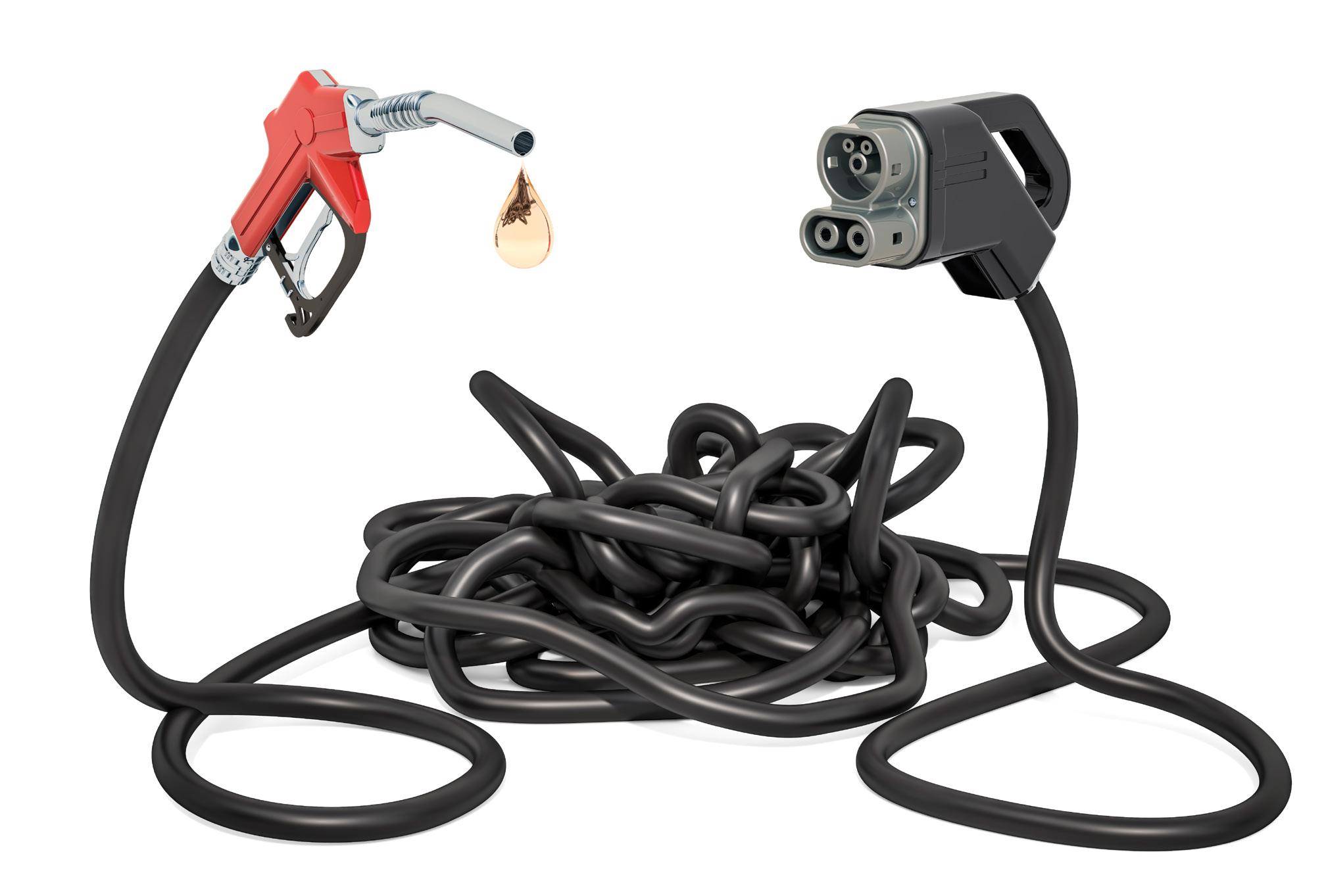


SPRING 2024 COVER STORY
40 44 34 FuelsMarketNews.com FMN Magazine SPRING 2024 | 1

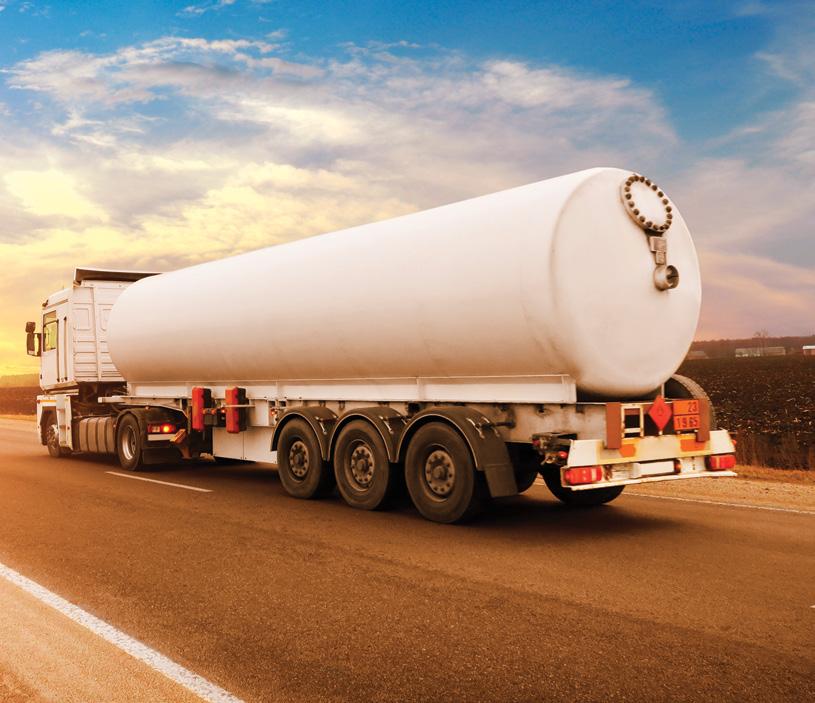

24 18 28 04 From the Editor 06 NACS News 10 Transportation Energy Institute 12 Fueled for Thought RETAILER OPERATIONS 14 Making the Forecourt a Customer’s Only Stop Convenience retail will continue to evolve. 18 Golden Footsteps EV charging stations have the potential to increase foot traffic. 20 Who’s Minding the Store? Keeping stores staffed is often the biggest challenge retailers face—it doesn’t have to be. 22 SIR and ATGs Are Meant to Live Together It should not be a discussion of either/or. Why not both? COMMERCIAL FUELS 24 Truck Innovation and Tradition Extend the range and efficiency of diesel trucks through innovation and helpful tips FUEL MARKETERS 28 A Generational Breakdown When Gen Z joins the family business, different expectation can collide. 30 Brand in Focus: Shell The company has three major initiatives driving value at retail. 46 Industry News 48 Remember This? FuelsMarketNews.com 2 | FMN Magazine SPRING 2024
MAKE GETTING AHEAD FEEL LIKE GETTING AWAY WITH SOMETHING.
Make a clean break with E15 & Flex Fuels — and give yourself a financial advantage the majors don’t want you to have. It’s more affordable for customers and more profitable for you with a federal HBBIP grant covering up to 75% of new equipment costs.
Add E15 & E85 today. We can help.
flexfuelforward.com

Energy Equity
Energy equity features prominently in this issue of the magazine. It basically involves the idea that all communities should have access to affordable energy to facilitate the needs of daily life, such as transportation. Much of the focus here is on the current state of electric vehicles and how they lack the affordability required in the most disadvantaged communities, as well as issues such as charger adoption in these communities.
The latest generation of cutting-edge near zero-carbon liquid fuels (e-fuels, renewable diesel, etc.) are hardly better. While they can make life easier on the fueling infrastructure side, the price per energy unit tends to be multiples of that for conventional fossil fuels when it comes to filling the tank. Time will ease this, but the scope of the challenge is enormous, encompassing not only all on-road and off-road vehicles but aircraft and shipping. Effective carbon-reduced fuels using more conventional biodiesel and ethanol can create significant carbon reductions at more affordable prices and yet come up short compared to the zero-carbon push.
The issues discussed in this magazine tend to be more microeconomic in nature, focused on specific families and communities, often in specific areas. However, the push for net-zero carbon raises these questions globally, and certainly not just with transportation fuels. For all the criticism they receive, including occasional “high prices,” conventional fossil fuels still provide the greatest bang for the buck to deliver cheap energy.
Cheap energy has done more to improve the quality of life than anything else. A classic example is the
industrial era, where coal ushered in an enormous net increase in quality of life.
There was significant pollution during the industrial revolution, of course (until less polluting fuels such as oil and gas and clean coal systems took hold), but the offset was a cast iron bed frame so that people no longer had to sleep on the floor. Boilers that allowed for hot baths and improved hygiene. Mechanization meant greater yields and easier lives for those still on the farms. Similar mechanization allowed for numerous, similar toiling tasks to be eased.
And getting back to transportation, the tailpipe might have made the air quality less pleasant and less safe, but it was considered a deliverance both in terms of ease of travel and (especially in the big cities) the pollution from the rear end of a horse.
Global energy equity concerns are real as we remake our current, mature, functional energy universe. What will be the impact, who will pay to subsidize those that can’t, how much will it cost, what will be the impact on agriculture, easy travel, quality of life? Important questions, but currently lacking any serious discussion as we forge ahead. However, there will be no free ride.
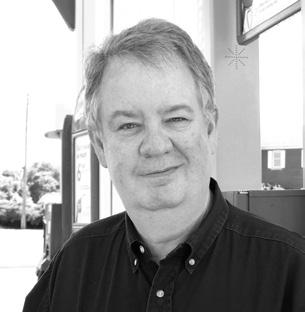
EDITORIAL Keith Reid Editor-in-Chief (847) 630-4760; kreid@fmnweb.com Ben Nussbaum Editorial Director (703) 518-4248; bnussbaum@convenience.org Lisa King Managing Editor (703) 518-4281; lking@convenience.org CONTRIBUTORS James (Jay) Burdette, Angela Clemente, John Eichberger, Victoria Flowers, Stephen Israel, John Kimmel, Reggie Roberson, Roy Strasburger DESIGN Imagination, part of The Mx Group www.imaginepub.com Cover image by malerapaso/Getty Images ADVERTISING Ted Asprooth (847) 222-3006; tasprooth@convenience.org PUBLISHING Stephanie Sikorski Publisher (703) 518-4231; ssikorski@convenience.org Nancy Pappas Marketing Director (703) 518-4290; npappas@convenience.org Logan Dion Digital Ad and Media Trafficker (703) 864-3600; production@convenience.org EDITORIAL COUNCIL RETAILER/MARKETER MEMBERS Mark Fitz, president, Star Oilco; Derek Gaskins, chief marketing officer, Yesway; Brian Renaud, director of retail fuel pricing and analytics, Sheetz; Scott Minton, director of business development, OnCue Marketing VENDOR/SUPPLIER MEMBERS Regina Balistreri, director of marketing, ADD Systems; Joe O’Brien, vice president of marketing, Source North America Corporation; Kaylie Scoles, marketing director, RDM Industrial Electronics Inc.; Ed Kammerer, director of marketing and global product strategy, OPW Retail Fueling Fuels Market News Magazine is published quarterly by the National Association of Convenience Stores (NACS), Alexandria, Virginia, USA. Subscription Requests: circulation@fmnweb.com POSTMASTER: Send address changes to Fuels Market News Magazine, 1600 Duke Street, Alexandria, VA, 22314-2792 USA. Contents © 2023 by the National Association of Convenience Stores. Periodicals postage paid at Alexandria, VA, and additional mailing offices. 1600 Duke Street, Alexandria, VA, 22314-2792 PUBLISHED BY Keith Reid is the editor-in-chief of Fuels Market News. He can be reached at kreid@fmnweb.com.
FROM THE EDITOR
FuelsMarketNews.com 4 | FMN Magazine SPRING 2024

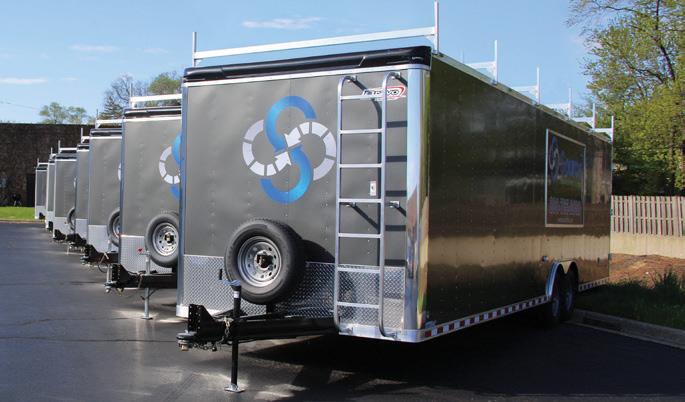









©2024 Source, A Source North America Company. All Rights Reserved. X Y C FOR FUELING EQUIPMENT C Warehouse on Wheels E-commerceSource Simple Solutions SOLUTIONS Design Group Retail Sales Solutions Source University Training Center SourceLine News & Insights Visit sourcena.com or call toll-free 800-572-5578. V Visit s at Booth 709 at M- C ! FRED M. WHITAKER, P.C. 2424S. E.BRISTOL STREET, SUITE 300, NEWPORT BEACH, CA (949)852-1800 FWHITAKER@CWLAWYERS.COM CUMMINSANDWHITE.COM More than 32 years of experience in P Mer Acquisitions, Real Estate, ent, Affairs, Estate & Tax Plann and Related Transactions
Insights From NACS Leadership Forum

Leaders from the convenience retailing industry convened on Amelia Island, Florida, in February for the NACS Leadership Forum. Networking and meetings were a priority for the attendees, but inspirational and educational presenters and panels were part of the draw. A variety of leaders shared their expertise and insights over the course of eight sessions, including the following.
LEADING WITH PURPOSE
NACS President and CEO Henry Armour and Sheetz CEO and President Travis Sheetz kicked off the event with a candid conversation about leading with purpose.
Travis Sheetz shared that the company thinks in terms of an employee value proposition, or what it can promise an employee: “We’re high energy, we’re family-oriented, we really focus on employees. We have tremendous growth opportunities,” Travis Sheetz said. He noted that,
particularly after Covid, people want to be “in the right place,” meaning at a company that values them.
Travis Sheetz noted how different CEOs of the company have each brought a different focus—less because of who that CEO was as a person and more because of what the company needed at the time. For Travis Sheetz, that means focusing on people. “The business model is good. Our business model works. … We’re growing. We need to focus on people.”
BECOMING AN EMPLOYER OF CHOICE
“It’s become harder on frontline people lately,” said Hunter Williams, partner–retail and consumer goods at Oliver Wyman. Convenience retailers and industry suppliers attending the Leadership Forum nodded in agreement.
Williams shared new research from the NACS Coca-Cola Retailing Research Council (NCCRRC) that highlights
FuelsMarketNews.com 6 | FMN Magazine SPRING 2024
Melanie Isbill, Kevin Lewis and Hunter Williams presented findings from the NACS/Coca-Cola Retailing Research Council.
Is your c-store brand showing up online?
INTRODUCING
Ensure accurate business listings on nearly 150 networks


an all-in-one search, social and reputation management tool designed especially for c-stores. Whether you have 1 or 500+ locations, NACS THRIVR delivers the foot traffic and growth you need to thrive and build basket size all around—from the first mile to the last.


Manage social media for multiple retail locations
Optimize local search rankings on Google, Yelp and more
Get started with a digital health check comparing your brand’s local marketing presence and online performance to top competitors and schedule an initial oneon-one information session at convenience.org/thrivr
BROUGHT TO YOU BY POWERED BY
NACS Leadership Forum (continued)
how convenience retailers can become employers of choice amid negative perceptions of the c-store industry.
The research is a call to action that the entire c-store industry can embrace, including by:
• Delivering on employee safety and investing in ways that benefit everyone in the industry.
• Making sure laws are enforced when it comes to protecting employee safety and the workplace.

• Investing in training and development to expand career opportunities and move beyond “just a job.”
• Changing the perception of convenience retail among the media and general public.
“It is in all of our collective interests to make that happen. … How can we hold hands as an industry and do this together? Because none of us, big or small, can do this on our own,” said Kevin Lewis, chief growth officer at Alimentation Couche-Tard, parent company of Circle K.

PUT YOUR PEOPLE FIRST
“The way people think about how work fits into their lives is drastically shifting,” said Hannah Ubl, co-founder of Good Company Consulting.
Remember the golden rule? Treat others the way you want to be treated. Today it’s the platinum rule: Treat others the way they want to be treated.
“Think about it as feedback, as recognition. We all have different preferences. … Communicate with others the way they want to be communicated with. If you’re thinking about how to create a people- first culture, it’s constantly making sure that you’re operating by the platinum rule,” she said.
Calendar of Events
APRIL
NACS State of the Industry Summit
April 03-05 | Hyatt Regency O’Hare Chicago Rosemont, Illinois
Conexxus Annual Conference
April 28-May 02 | Live! By Loews Arlington Texas
JUNE
NACS Convenience Summit Europe
June 04-06 | Intercontinental Barcelona
Barcelona, Spain
JULY
NACS Financial Leadership Program at Wharton
July 14-19 | The Wharton School, University of Pennsylvania Philadelphia, Pennsylvania
NACS Marketing Leadership Program at Kellogg
July 21-26, 2024 | Kellogg School of Management | Northwestern University
Evanston, Illinois
NACS Executive Leadership Program at Cornell
July 28-August 01 | Dyson School, Cornell University Ithaca, New York
OCTOBER
NACS Show
October 07-10 | Las Vegas Convention Center
Las Vegas, Nevada
For a full listing of events and information visit www.convenience.org/events.
Hannah Ubl of Good Company Consulting spoke on putting your people first.
Travis Sheetz and Henry Armour kicked off the event with a discussion on leading with purpose.
FuelsMarketNews.com 8 | FMN Magazine SPRING 2024

Driving the industry forward, together
Convenience is always evolving, but NACS delivers the insights and innovative tools to help retailers win. Our latest initiatives improve how you serve your customers and communities and keep your business one step ahead.
Revolutionizing age verification at the register and beyond

Optimizing retailers’ digital presence to drive traffic & growth

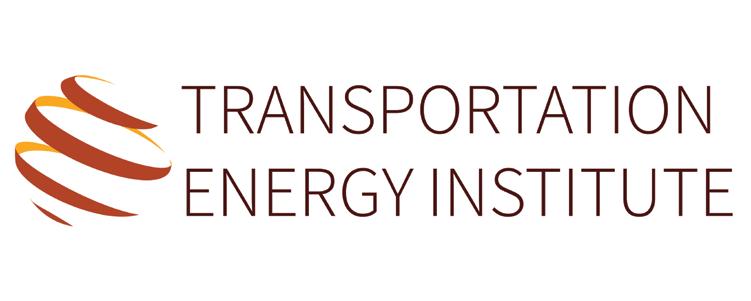
My New Vehicle Search
Alternative infrastructure has a long way to go.
BY JOHN EICHBERGER
Irecently secured an apartment in Huntington Beach, California, a part time residence where I can stay when visiting my family in Southern California. In setting up this home away from home, I have been looking for a vehicle. Given my role at the Transportation Energy Institute, I thought it might be educational to try an alternative vehicle. Well, that is easier said than done, even in Southern California. Here is what I have discovered as I explored my options.
ELECTRIC VEHICLE
California is far and away the leader in the EV transition, with more registered vehicles and charging stations than any other state. The government has also adopted a policy to eliminate the sale of combustion engine vehicles by 2035. Given those facts, I figured it should be easy to transition to an EV here – but not so fast.
First of all, the apartment I rented does not have charging stations for EVs and when I asked if level 2 charging, for renters, was in their future plans I was met with a blank oblivious look. I am fortunate to have a first-floor unit with a gate that leads to the parking area, but the parking space assigned to my unit is not accessible to an extension cord and does not have a power outlet to support even a Level 1 charger. I have no way to charge a vehicle at home, which means I need access to a public charger.
Unfortunately, the number of DC fast chargers in the Huntington Beach area is limited. In fact, according to the Department of Energy’s Alternative Fuel Database Center, there are only a handful of DC fast chargers within a few miles of my apartment. PlugShare shows the same number of fast chargers in the area, so I am pretty confident the population of options is limited. And if you are familiar with Southern California traffic, a few miles can take 20 minutes or more to travel. I know more public chargers are coming sometime in the future, but I need to make a vehicle decision now.
HYDROGEN
I have long been a fan of hydrogen fuel cell vehicles and discovered I could acquire a pre-owned FCEV for under $10,000. But again, as I looked at the market, refueling became a concern. California is the only state that has truly supported H2 infrastructure to date, but a look at the available options in the area left me wanting. There are two retail H2 stations within about five miles of my apartment, but
beyond that the landscape is pretty sparse.
There also is some sticker shock when I think about the price of H2 –$30/kg or more. According to some sources, I could get about 60 miles per kg, so that comes out to $0.50/mile. By comparison, if I were to drive my old Jeep Wrangler, which averaged about 18 miles per gallon, and paid $4.50 per gallon, I would be spending about $0.25/mile. That is a bit tough to swallow.
FLEX FUEL VEHICLE
Another option I could consider is a flex fuel vehicle that can operate on straight gasoline or ethanol blends up to E85. In this scenario, I could refuel anywhere with gasoline and, when available, purchase E85 and save quite a bit of money at the pump. (Currently, E85 is selling for less than $4.00/gallon in Southern California.) And while production of FFVs has waned dramatically in recent years, there remain millions on the road and in the used vehicle market.
In terms of infrastructure for E85, AFDC shows there are a couple options in my area, but nothing really close. That said, I did notice when visiting my sister in Fullerton that there is an E85 station just down the street from her house, so the option to fuel with
FuelsMarketNews.com 10 | FMN Magazine SPRING 2024
E85 would exists occasionally but I wouldn’t have to use E85 unless it was convenient for me to do so.
But there is another challenge – finding an FFV on the used car market. I spend a lot of time perusing the AutoTrader app, but when I tried to search for available FFVs, there is no such filter. So, finding one would require determining which vehicles in which years were available in FFV and then scrubbing used vehicle listings and calling dealerships to discover if their available vehicle is an FFV.
DIESEL
I love my Wrangler (I would love to drop the top, remove the doors and head to the beach!) and did a search at nearby dealers to see what deals might be available. One dealership has two 2022 Wranglers equipped with a diesel engine available for a massive discount. These Wranglers boast a fuel economy of about 25 miles per gallon, which is only slightly better than the 22 mpg rating for a typical gasoline version. But then I looked and found that diesel is selling for about $5.00 per gallon, a 50-cent jump over unleaded.
What about renewable and biodiesel? I looked to see what my options were
to purchase a lower emitting, lower price biodiesel or renewable diesel. The vast majority of renewable diesel in the U.S. is being sold in California due to the policy incentives, so I was hopeful. But it seems where I have decided to reside is the Death Valley for alternative energy – there is only one renewable diesel and no biodiesel stations listed in AFDC in the area around Huntington Beach. If I can stomach the price per gallon increase, I still need to weighout the inconvenience factor of driving extra miles to fill-up.
WE MUST COLLABORATE TO BUILD INFRASTRUCTURE
My research demonstrates we have a lot of work to do if we want any alternative vehicle and energy option to be a market success. I really expected that Southern California would present me with more options than it has.
While I am disappointed, I don’t consider the results a negative reflection on any vehicle or energy option – it is simply today’s reality. If we want to transition to lower energy intense and lower emissions transportation options, we have to make sure the infrastructure exists to support it – and we have a long way to go.
The vast majority of renewable diesel in the U.S. is being sold in California due to the policy incentives, so I was hopeful. But it seems where I have decided to reside is the Death Valley for alternative energy.

John Eichberger is the executive director of the Transportation Energy Institute.
FuelsMarketNews.com FMN Magazine SPRING 2024 | 11

Ethanol’s Next Frontier
Three highlights show ethanol’s promising future.
BY JOE O’BRIEN
In July 2023, the EPA issued final renewable fuel volume obligations (RVOs) for 2023-2025. The final RVOs were lower than the EPA’s proposed volumes, and as such, this was largely viewed as a setback for conventional renewable fuels.
Yet, there is reason for optimism, particularly for ethanol, which is poised for expansion despite the lean RVOs. Here are three reasons why the staying power of ethanol will likely intensify in the coming years.
1. THE EXPANSION OF SUSTAINABLE AVIATION FUEL (SAF) TOOK A STEP FORWARD.
The U.S. Department of Energy reports that aviation greenhouse gases (GHGs) account for up to 12% of U.S. transportation GHG emissions. While long-term solutions for reducing aviation GHGs may eventually include electric and hydrogen-fueled planes, the complete implementation of those technologies is a long way off.
Sustainable aviation fuel (SAF) represents a viable energy form that can be deployed in the near term. To that end, the White House’s Sustainable Aviation Fuel Grand Challenge was established with the goal of producing at least three
billion gallons of SAFs by 2030.
As airlines are proving out the feasibility of SAF as a drop-in replacement for fossil-fuel derived jet fuel, the federal government has been taking steps to develop a framework for tax credits that will incentivize the production of SAF. In December the Biden administration said it would recognize the Department of Energy’s greenhouse gases, regulated emissions and energy use in technologies (GREET) model that will enable ethanol-based SAF to qualify for the tax credits.
Critics have voiced skepticism that ethanol alone would lower the GHGs in SAF enough to qualify for the tax credits, and a report prepared for the Air Transport Action Group indicated that current feedstock availability will pose a significant challenge in meeting decarbonization goals. That notwithstanding, new ethanol-to-jet fuel processing technology is showing promise when used in conjunction with cleaner production technologies and sustainable farming practices.
2. SALES OF E15 ARE ON THE RISE. There are strong indications that sales of E15 will swell in 2024.
FUELED FOR THOUGHT
FuelsMarketNews.com 12 | FMN Magazine SPRING 2024
First, E15 sales have been on an upward trajectory for the past two years. According to data from the Renewable Fuels Association, E15 sales surged in the summer of 2023. Sales volumes from the Minnesota Department of Commerce, which is the only monthly E15 data set available, rose 10 percent compared to sales in the summer of 2022.
Second, in April 2022, eight Midwestern states filed petitions with the EPA requesting the agency remove the 1-psi Reid vapor pressure (RVP) waiver for summer gasoline-ethanol blended fuels. If the EPA agreed, it would enable E15 to be sold year-round in Illinois, Iowa, Minnesota, Missouri, Nebraska, Ohio, South Dakota and Wisconsin. Additionally, Montana became the 49th state to allow retail sales of E15 (California is the only state that has not approved E15 for retail sale).
After extensive delays, the EPA delivered its final rule to the White House Office of Management and Budget for review at the end of 2023, signaling that the rule could potentially take effect by the 2024 summer driving season. Expanded supply of E15 in the Midwest may set the stage for yearround E15 nationwide.
3. POLICYMAKERS ARE PURSUING LEGISLATION THAT WOULD CREATE A NATIONAL HIGH-OCTANE, LOW-CARBON FUEL STANDARD.
According to the Renewable Fuels Association, the Next Generation Fuels Act will establish the standard for high-octane (95 RON ramping up to 98
RON) and low-carbon fuels. To meet the standard established in the act, the source of the octane boost must reduce GHG emissions by 40% compared to today’s gasoline.
The bill doesn’t dictate how regulated parties must achieve the higher octane and lower carbon requirements. But presumably, higher ethanol blends could play a significant role in achieving those goals.
If signed into law, the Next Generation Fuels Act would require more efficient high-octane, lower-carbon fuels beginning in 2028.
CONCLUSION
Although SAF, E15 and a high-octane, low-carbon fuel standard will propel ethanol forward, there are other factors likely to increase ethanol production.
Beyond the national fuel standard, the ethanol industry also stands to gain from state-level clean fuel standards. California, Washington and Oregon have already established their own clean fuel standards, and standards are pending in at least 10 other states.
Furthermore, funding for higher ethanol blends infrastructure continues to flow. The U.S. Department of Agriculture is awarding $450 million in grants through its Higher Blends Infrastructure Incentive Program (HBIIP), with application windows scheduled through Sept. 30, 2024.
And while ample policy support is certainly a contributing factor toward ethanol’s success, the fact that this fuel enjoys bipartisan support may be the single greatest thing going for the fuel amid today’s political climate.
As airlines are proving out the feasibility of SAF as a dropin replacement for fossil-fuel derived jet fuel, the federal government has been taking steps to develop a framework for tax credits that will incentivize the production of SAF.

Joe O’Brien is vice president of marketing at Source North America Corporation. He has more than 25 years of experience in the petroleum equipment fuel industry. Contact him at jobrien@sourcena.com or visit sourcena. com to learn more.
FuelsMarketNews.com FMN Magazine SPRING 2024 | 13

Making the Forecourt a Customer’s Only Stop
Convenience retail will continue to evolve.
BY JAMES (JAY) BURDETTE
Since the first purpose-built, drive-up gas station opened in 1913, at a time when there were only 500,000 vehicles on the road, the role of the station has been to provide car-related services. From its main priority, fuel, to things like oil checks, tire pressure fills tand
even car washes, the gas station has evolved quite a bit. However, over the past decade or two, the focus has shifted beyond basic car maintenance. Now, stations must offer customers an array of services, spanning their needs as both a driver and a retail consumer. In fact, a Salesforce report showed
62% of consumers expect companies to anticipate their needs. A McKinsey & Company report showed 71% of customers expect personalization from the businesses they regularly frequent. Noncash retail payment transactions grew 13% between 2018 and 2021 according to McKinsey & Company. The digital payments market is expected to reach $170.95 billion in 2026, according to the Digital Payments Global Market Report 2023. Gas station owners need to spark a digital-first mindset as they look to increase traffic. By maintaining a digital mentality and infusing the latest technology into forecourt operations, gas stations can offer an enhanced experience.
RETAIL OPERATIONS JONI HANEBUTT/SHUTTERSTOCK
FuelsMarketNews.com 14 | FMN Magazine SPRING 2024
MAXIMIZE TIME THAT CUSTOMERS SPEND FUELING WITH POS INNOVATION
To make the buyer experience as efficient as possible, gas station owners should look to easy-to-use technology. Solutions like self-serve kiosks allow for customers to pay for their refuel in an easy manner, with the option to add on food and beverage all in one application. Not only do self-serve kiosks give customers an option for a one stop shop, but they also provide gas station owners the opportunity to increase revenue by upselling. With digital kiosks, the average revenue per customer is 12-20% higher than with cashier service, according to Aberdeen Strategy & Research, and this can even reach 30% in some business use cases. For a streamlined retrieval process, gas stations can implement a to-go pickup window where customers can pick up their items without having to enter a storefront. This integrated approach turns the gas station forecourt into a multipurpose space for customers.
For customers who do prefer in-store, installing flexible POS terminals can enable a smoother experience for all. With ongoing staffing challenges, advanced POS systems can adapt from a staff-run technology to an easy-to-use self-checkout kiosk. The technology can also support gas station managers by identifying purchasing patterns and customer preferences that help managers control inventory and assign staff effectively throughout weekly shifts. Digital POS systems are a great solution for both meeting customer demands and staffing challenges—all while improving a business’ ability to make data-driven decisions.
INCREASE YOUR CUSTOMER BASE WITH DIVERSE OFFERINGS
Many gas stations are expanding their customer offerings to bring in new business. Going beyond the traditional
pit stop and broadening the gas station use case will help retailers succeed in the coming years. One example of this expanded offering benefit is clear with the prevalence of electric or hybrid vehicles. With electric vehicle sales tripling from 2020 to 2022, according to IEA, and more growth imminent, those who don’t make room for hybrid or EV charging within the forecourt may fall behind. Based on current trends, the rollout of EVs is set to reduce the need for oil by five million barrels a day by 2030.
Knowing that EV drivers can spend upwards of an hour at a charging station, according to the U.S. DOT, there is a new business opportunity for gas station owners that has never been present before. Consumers once wanted to get in and out of the store as fast as possible, but the reality of electric vehicle charging is that it takes time. So, with this added time, gas station owners need to rethink their retail experience to take advantage of downtime at the charger and the pump. Beyond fueling, gas station owners must meet their customers’ needs for an enhanced retail experience. While customers wait for their tanks to fill or batteries to charge, they should be able to take advantage of downtime for other potential needs such as traditional grocery shopping or grabbing a coffee or meal. By providing multiple energy solutions, these retailers can engage a variety of customers with new, diverse needs. This will change the sales mix configuration and provide new sources of revenue for their business.
LEVERAGE THE POWER OF DIGITAL SIGNAGE TECHNOLOGY
While optimizing the forecourt is a strategic way of increasing revenue, there’s still opportunities to maximize in-store purchasing decisions. When used correctly, digital signage can be a powerful tool for information
To make the buyer experience as efficient as possible, gas station owners should look to easyto-use technology. Solutions like selfserve kiosks allow for customers to pay for their refuel in an easy manner, with the option to add on food and beverage all in one application.
RETAIL OPERATIONS
FuelsMarketNews.com FMN Magazine SPRING 2024 | 15
Consumers once wanted to get in and out of the store as fast as possible, but the reality of electric vehicle charging is that it takes time. So, with this added time, gas station owners need to rethink their retail experience to take advantage of downtime at the charger and the pump.
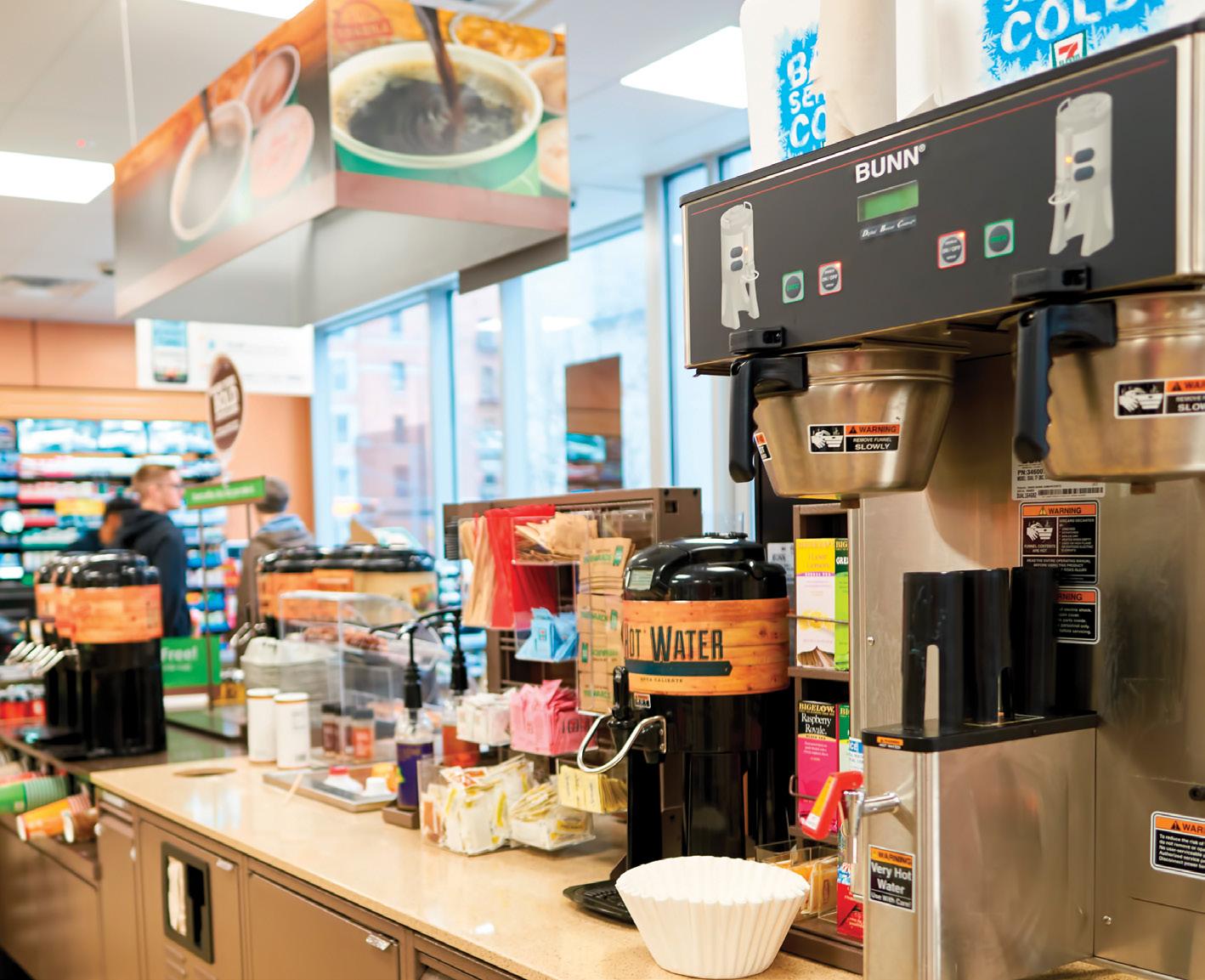
sharing. In fact, the automotive and CPG food markets saw up to 27% sales ROI increases by using out-of-home advertising and digital information sharing in 2023, according to Benchmarketing.

Gas station owners can highlight new products, daily deals and promote the variety of in-store products they have for purchase. When displays are integrated with inventory systems, information shared with customers can reflect current availability on a moment’s notice. Durable displays can even be placed outdoors to grab customers’ attention from the comfort of their car. These displays, often towering over major highways and public spaces, command the attention of passersby and can convey messages with extreme clarity. Outdoor displays offer vibrant visuals that ensure a wider reach and maximize any business’s exposure—all while seamlessly blending in with modern cityscapes.
DIGITAL-FIRST CONSUMERS DESERVE DIGITAL-FIRST RETAIL EXPERIENCES
As the consumer mindset shifts to be more cognizant of digitally native and sustainable experiences, it’s important that retailers and brands work to meet this expectation. No matter what kind of business you run, this is an achievable goal with the help of technology. From making small adjustments to payments operations to updating digital signage solutions, gas station owners can quickly get ahead of the competition by meeting their customers where they are today and in the near future. With advanced retail technology, gas station owners can create a true connected retail operation where digital signage, POS terminals, mobile devices and kiosks work in tandem to create an intelligent communications network. This will bring on greater customer engagement and in-store efficiency for managers and staff members.
RETAIL OPERATIONS
SORBIS/SHUTTERSTOCK FuelsMarketNews.com 16 | FMN Magazine SPRING 2024
James (Jay) Burdette is the senior director of the Enterprise Process Innovation Center at Panasonic Connect North America. Panasonic Connect is a B2B company offering device hardware, software and professional services for the connected enterprise.
Executive Education
Equipping today’s leaders for tomorrow’s challenges.
From disruption comes opportunity. At this very moment, the convenience industry is rich with possibility. The key to success? Leaders who can forge a new path. Informed, confident and nuanced leaders are the best asset an organization can have. NACS Executive Education has partnered with world-class, Ivy League institutions — boasting some of the best educators in the world — to provide exclusive education to shape the forward-thinking, determined leaders who will illuminate and seize the opportunities of tomorrow.
convenience.org/NACSExecEd

July 14-19, 2024
The Wharton School University of Pennsylvania Philadelphia, PA
July 21-26, 2024
Kellogg School of Management Northwestern University Evanston, IL
July 28 –August 1, 2024
The Dyson School Cornell University Ithaca, NY
November 3-8, 2024
MIT Sloan School of Management Cambridge, MA
November 17-22, 2024
Yale School of Management New Haven, CT
Endowed by: (Exclusive) Endowed by: Endowed by: (Exclusive) Supported by: Endowed by:













The NACS Master of Convenience designation acknowledges the leaders from around the globe who have invested in their personal leadership development and attended 3 or more NACS Executive Education Programs. Learn more at convenience.org/NACSMaster

Golden Footsteps
EV charging stations have the potential to increase foot traffic.
BY STEPHEN ISRAEL
Retailers recognize the symbiotic relationship that has long existed between brick-and-mortar businesses and consumer passenger vehicles and are taking steps to accommodate the new crop of EV customers.
7-Eleven, the country’s largest convenience store retailer, has taken a step forward with initiatives such as its 7Charge network and app. By introducing a proprietary EV charging station network and app, the retailer’s goal is to become a top EV charging hub in North America. Not to be left behind, Subway is launching Subway Oasis charging parks. As other examples, Starbucks is busy collaborating with Volvo and IKEA announced its plans for EV charging stations.
EV drivers give retailers a golden opportunity for increased in-store traffic, or at least longer in-store dwell times, while these customers wait for their vehicles to charge. The longer charging time compared to the time spent pumping gas means EV owners are more inclined to enter nearby stores.
In fact, some studies are beginning to indicate that the presence of a charging station positively influences a consumer’s decision to patronize a specific location. A recent survey reveals that the vast majority of EVgo users, or 80%, shop at local retailers while charging. Another statistic shows that these consumers on average spend an amount within the retail location exceeding $1 for every minute their cars charge.
This retail phenomenon translates across industry segments. A multinational hotel chain found that its decision to offer guests EV chargers attracted more overnight guests and encouraged visits to lounges and restaurants. Finally, installing commercial EV charging stations offers the ancillary benefit of enhancing a company’s brand image by catering to an environmentally conscious demographic.
PAYING AT THE ‘PUMP’ FOR FAST EV CHARGING
While many EV owners can charge their vehicles at home, they are willing to pay a premium for on-the-go charging solutions that help them reach their final destinations or save them time. An E Source survey found that a considerable portion of EV users would willingly pay up to $3 to $4 per hour for charging. This is significant, since the same users might only spend an average of $0.75 per hour to charge at home.
They will pay these fees for the sake of convenience or to alleviate range
RETAIL OPERATIONS
PHONLAMAI PHOTO/SHUTTERSTOCK FuelsMarketNews.com 18 | FMN Magazine SPRING 2024
anxiety when on an extended road trip. In certain critical situations, 7% of the surveyed users said the price didn’t matter if it meant avoiding a dead battery.
STRATEGIC CHARGING PLANS AND ADDITIONAL REVENUE STREAMS
Commercial EV charging stations can generate revenue in several ways beyond the simple act of charging the vehicle, including through various charging plans and selling ancillary products and services.
A tiered charging plan or subscription offers a versatile approach to generating revenue across several types of establishments. Medical facilities, for instance, can offer patients and visitors flexible charging options to use the EV charging stations during appointments while also leveraging the display on the charging station to promote other on-site services such as nutrition or wellness classes, dermatological treatments and more.
An office building can introduce tiered or subscription-based charging as an exclusive reward for tenants, a value-added service for visitors for use during meetings or to entice potential new renters. These charging models can incorporate perks and programs that help foster customer loyalty while opening new revenue streams simultaneously.
Retail outlets can monetize this display by collaborating with brands and advertisers for sponsored charging sessions. Picture an EV owner who plugs in their vehicle and sees a message stating, “This charging session is brought to you by [insert brand name].” This approach can offset the cost of electricity and drive brand engagement for all types of retailers, including large shopping malls, movie theaters or lifestyle centers. These venues attract
a diverse clientele, which makes them attractive for brands targeting a wide market. Exclusive deals, promotions or limited-time offers related to the sponsoring brand entice the consumer to spend more or feel a sense of urgency related to making a purchase.
While the time is right to install commercial EV charging stations, it is important to install the right equipment designed to accommodate car batteries now and future battery technologies in development. Fast chargers such as BTC Power’s Gen4 180 kW can supply enough power to reach 80% for an average electric vehicle battery in less than 15 minutes. Fast chargers still provide plenty of time in the store while offering customers a more convenient and efficient experience.
EXPLORING EV CHARGER FUNDING AND GRANTS FOR FASTER ROI
While installing EV charging stations can represent an investment, businesses can explore grants and subsidies to offset these costs, resulting in a faster ROI. The United States made significant strides toward strengthening its EV charging infrastructure with its launch of the National Electric Vehicle Infrastructure (NEVI) Formula Program.
This initiative channels up to $7.5 billion that individual states can distribute to retailers along designated travel corridors. For retailers located in rural areas, check on available funding. The NEVI funding program emphasizes building infrastructure in marginalized communities.
The current landscape enables companies to leverage these federal tax credits and incentives for commercial EV charging installations. This allows companies to modernize their commerce strategies and witness an uptick in consumer traffic.
EV drivers give retailers a golden opportunity for increased in-store traffic, or at least longer in-store dwell times, while these customers wait for their vehicles to charge.

RETAIL OPERATIONS
veteran ranging from System Architecture Design, Asset Operations, Station Design Build
his career working for
Stephen Israel Senior Director of Product Management Stephen Israel is a 14-year Electric Vehicle Charging
Stephen started
FuelsMarketNews.com FMN Magazine SPRING 2024 | 19
Stephen Israel is the senior director of product management for BTC Power, a leading manufacturer of electric vehicle charging systems in North America. BTC Power’s product portfolio consists of both DC and AC charging systems with power ranges from 6.6kW to 350kW.

Who’s Minding the Store?
Keeping stores staffed is often the biggest challenge retailers face—it doesn’t have to be.
BY ROY STRASBURGER
It is a call I dread. Around 11 o’clock in the evening, the phone rings. On the other end of the line is a store employee who says that she really has to go home at the end of her shift because her child is sick. The problem is that her replacement, the person working the next shift, hasn’t arrived at the store and has not called in. The employee asks me what she is supposed to do as she needs to be leaving in fifteen minutes
and she could not reach anyone else. Not the end of the world, but a recurring frustration.
The employee component has always been the most challenging, and the most rewarding, part of retail operations. It is rewarding because it is an opportunity to teach people new skills, build confidence, help feed their families and provide them with a platform from which they can move up in the company.
It is challenging because, let’s be honest, we are dealing with human beings and all the variables (rational and irrational) that go with it.
Staffing is a major issue and was the subject of the January Convenience Leaders Vision Group (CLVG) meeting. Michael Sansolo presented the new Coca-Cola Retail Research Council (CCRRC) study that looks at the scarcity of labor and the need to retain employees. It was an enlightening discussion, and you can find the Vision Report that captures it at www.tvgsolutions.com.
Finding employees has been a big challenge for most of my career. The obstacles include the hours that need to be worked, the tasks that need to be done during the shift and the perception that working in a c-store is a
RETAIL OPERATIONS ODUA IMAGES/SHUTTERSTOCK
FuelsMarketNews.com 20 | FMN Magazine SPRING 2024
menial and dangerous job.
The CCRRC report defines those challenges and adds some additional factors: the small percentage of the working population that is interested in working in the convenience industry, competition with the gig economy and the lack of perceived career path opportunities. These issues, combined with a tight labor market with low unemployment, means that finding qualified people to provide excellent customer service, represent our brand, and protect our assets is becoming harder.
The CCRRC report suggests several strategies for attracting new employees. First, you have to offer a wage that is competitive with other retail locations in your area. Everyone is looking for employees, and companies with the best pay and benefit packages that people want (such as 401(k) contributions, and mental health and financial counseling) have a head start in finding recruits.
Second, you need to emphasize the advantages of the flexible work hours that a convenience store can provide. Since gig work allows people to customize their work schedule, we need to do the same in our industry. This may mean rethinking what we mean by “full time” employees. Perhaps they work two, four-hour shifts per day rather than a straight eight hours.
Third, we need to emphasize the job skills (customer service, technology, food preparation and safety, etc.) that can be acquired while working in a front-line position and that these skills can be leveraged into longer-term career opportunities at your company.
If you are large enough, show that there is a reasonable career path from a part-time cashier to a full-time member of the operations, marketing, accounting or IT team.
Fourth, tell everyone the mission of your company and how you are helping the greater good. Applicants want to know that they are joining a company that will enhance the community and that they will be contributing to a worthwhile cause.
If you don’t have a mission, get one— and be serious about it. You can help the community or the neighborhood by providing resources, contributing to local events and organizations or working to become a more sustainable business. I want to be very clear on this—don’t say you’re doing something and then not do it. That is the fastest way to ruin your reputation with your employees and your customers.
Finally, and most importantly, it is about what happens when the person decides to join your company. You need a good, comprehensive onboarding process so that the employee knows what is expected of them and what is expected of you. Critical to this, and it came up several times in the CLVG meeting, is that the store manager will make, or break, the employee. The key to a successful store, high employee retention and low shrink is a manager that is engaged and cares.
If you follow these suggestions, there is a good chance that you will have enough quality applicants to keep your employee rosters full and your stores fully staffed and open. That way you won’t get the call in the middle of the night about an unmanned store.
The employee component has always been the most challenging, and the most rewarding, part of retail operations.
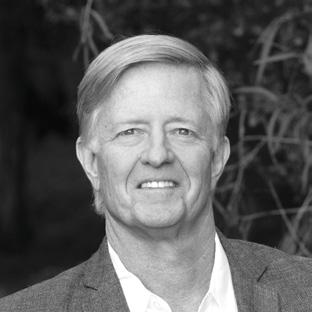
RETAIL OPERATIONS
Roy Strasburger is the CEO of StrasGlobal. For 35 years StrasGlobal has been the choice of global oil brands, distressed assets managers, real-estate lenders and private investors seeking a complete, turnkey retail management solution.
FuelsMarketNews.com FMN Magazine SPRING 2024 | 21
SIR and ATGs Are Meant to Live Together
It should not be a discussion of either/or. Why not both?
 Reggie Roberson CEO, Tank Management Services, Inc. www.TankMgmt.com
Reggie Roberson CEO, Tank Management Services, Inc. www.TankMgmt.com
We all love our automatic tank gauges (ATGs) to help keep underground storage tanks (USTs) and aboveground storage tanks (ASTs) in compliance. I sold hundreds of them in my 40-year career in petroleum equipment sales, service and installation. But we’ve left a technology behind that is still a backbone to a successful fuel management program—statistical inventory reconciliation (SIR).
In the last 40 years, we have made a mad dash to get out of the cold, rain, sleet, snow and hail by upgrading from the process of tank sticking to ATGs. However, we overlooked some important things while believing that our ATGs were fully

protecting us. All “Tommy Boy” movie fans know about taking the butcher’s word for it, but sometimes the butcher is off his game. What does that mean? Well, the best electronic line leak detectors available on the market are only 99% accurate, because sometimes your ATG goes down.
During the pandemic when supply chains were disrupted, there were stories circulating in the industry about over a year going by before getting replacement parts. Does that mean the business at hand was out of compliance for a year—yes. In most states that is a serious issue, and for the property owner, potentially catastrophic.
But even before the pandemic, the process was all too routine. I admit that in my previous job I was personally not focused enough on the fact that my customers were out of compliance for short or prolonged periods of time. I guess I figured that if the regulators weren’t breathing down our necks, then it wasn’t necessarily a problem. We were all doing the best that we could. My techs went to the site, we ordered parts if we didn’t have them in stock, and they would arrive when they arrived. Did many of us actually worry that the site was out of compliance? I never had a facility owner call me and say they couldn’t sleep at night because
PAUL VASARHELYI/SHUTTERSTOCK FuelsMarketNews.com 22 | FMN Magazine SPRING 2024

their ATG was down.
Too many of us have lost touch as to what ATG’s were originally designed to accomplish, which was to alert us to leaks and maintain compliance. How could we forget? But when the ATG fails, what happens? Well, there is an alternative.
In May 2023, I was hired to work as CEO for a company called Tank Management Services (TMS). They have been offering SIR for over 25 years as well as many other helpful services for UST and AST tank operators.
You may think that SIR is only a service that our grandfathers used and that it’s now obsolete. That is not the case. It is still a viable and approved method to monitor a UST or AST and remain in compliance and is sophisticated in today’s applications. An SIR service analyzes all variables including sales, stock levels and delivery data (we use DFS’ ClearView) to keep a fueling facility compliant without the need for additional equipment. It also enables tank operators to identify unexplained shrinkage. The process has the site operator stick the tanks, then log in and enter the data on a daily
basis. Then, at the end of the month, request the tank report. It is an appealing option for several reasons:
• SIR is inexpensive. It’s almost dirt cheap when compared to other operating expenditures.
• Everyone with a UST can still use this as their primary mode of leak detection, and they can certainly use it as a backup to their ATGs. Because SIR is so inexpensive, there is no need to even chance the possibility of being out of compliance if ATGs fail.
It may seem like a waste to invest in SIR just to back up an ATG, but do you really want to risk losing expensive fuel while facing a public relations crisis and a remediation nightmare? Not only is the cleanup expensive, but it typically shuts down the business, either temporarily or possibly even permanently. Further, can you fully rely on a regulator being sympathetic if it takes a significant amount of time to get an ATG back up and running? Maybe, maybe not.
Critics will tell you that SIR reconciliation takes weeks to uncover a leak. However, this statement is not true if you perform the SIR process correctly. Our site operators will typically get a report back within two to five business days. When properly conducted, SIR offers the ability to know every morning if you have a leak. Of course, most tank gauges and alarms are not looked at every day, either.
Keep your ATGs active because they are extremely beneficial. But at the same time, consider SIR as a backup tool for leak detection. Adding SIR would be like adding an inexpensive insurance policy that makes great financial sense. The conversation within the petroleum industry should not be an argument regarding SIR versus ATGs. Instead, the discussion should be about SIR taking your ATGs out to dinner, falling in love at first sight and then spending the rest of their useful lives together.
TMS is a wholly-owned subsidiary of Fuel True Independent Energy and Convenience Association and provides a complete line of services to help tank owners with programs to enhance their bottom lines. Some of these programs include Class A/B & C operator training, an SIR inventory management program, DOT training and mock audits, as well as its EDI tax program and liability insurance. Call Tank Management Services at (785) 2331414 for more information or visit www.TankMgmt.com for a free quote. New customers: mention this article for a special bonus (expires 5/30/24).

This content is brought to you by Tank Managment Services, Inc.
FuelsMarketNews.com FMN Magazine SPRING 2024 | 23
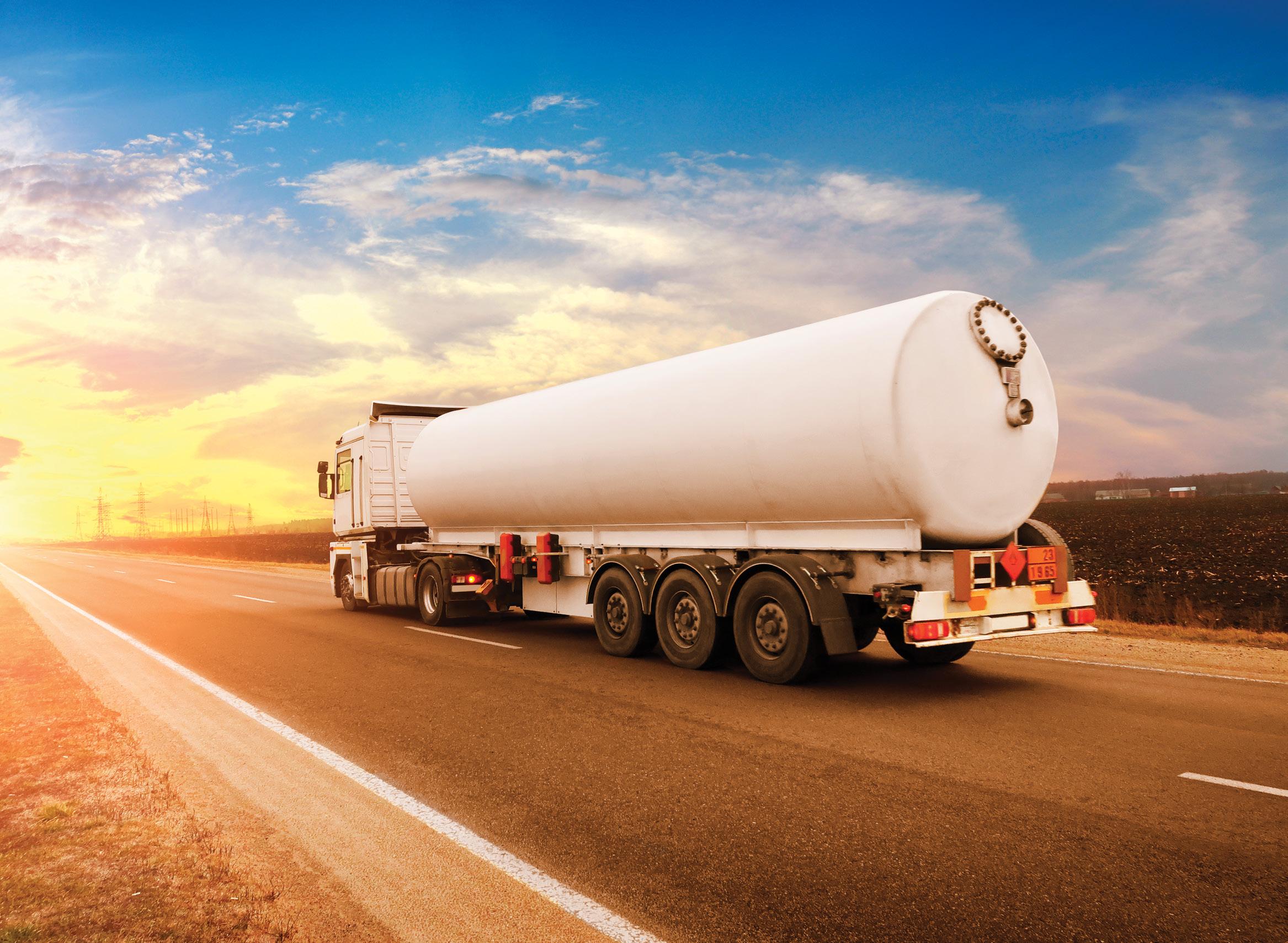
Truck Innovation and Tradition
Extend the range and efficiency of diesel trucks through innovation and helpful tips.
BY ANGELA CLEMENTE
Arange of advancements that are redefining the capabilities of diesel-powered heavy-duty vehicles can be combined with traditional best practices to help extend the range and efficiency of diesel semitrucks. Let’s dive into some of these and see how to be more efficient on the road.
THE CRUCIAL BREAK-IN PERIOD
Far from a mere formality, the break-in period is vital for diesel engines, providing intentional stress that induces
maximum heat and pressure, stopping just short of overheating or abuse. This is a vital step before attempting the innovative process in this article. Why?
• Elevating the temperature of engine components, ensuring optimal mating
• Inducing a necessary degree of wear on specific parts, enhancing interaction efficiency
Failure to adhere to a proper break-in process can negatively affect diesel engines. Engine components, if not
correctly mated, seated or worn, compromise the engine’s overall performance.
LEVERAGING ADAPTIVE CRUISE CONTROL
We’ve all heard the repair-or-replace question, but what if there was a third choice: neither! Integrating advanced technologies optimizes the efficiency and performance of diesel engines, saving us from facing the repair-orreplace question sooner than required. Adaptive cruise control (ACC) changes the game, especially compared to traditional cruise control systems that maintain a constant speed. ACC introduces a dynamic and adaptive element that leverages the vehicle’s momentum, thus reducing the need for frequent braking.
At its core, adaptive cruise control relies on a network of sensors and radar to monitor traffic conditions in real time. This sophisticated system
COMMERCIAL FUELS DMYTROPEROV/SHUTTERSTOCK
FuelsMarketNews.com 24 | FMN Magazine SPRING 2024
maintains a preset speed and intelligently adjusts the vehicle’s velocity based on the surrounding traffic flow. ACC lets drivers harness the existing momentum of the diesel engine by strategically adjusting speed without abrupt braking, minimizing unnecessary energy dissipation.
IMPLEMENTING FUEL MANAGEMENT SOFTWARE
Fuel management software like Fleetio and Wialon are at the forefront of a digital revolution, providing truck owners with a powerful means to track, analyze and optimize fuel consumption data.
Fuel management software captures data related to fuel usage, vehicle performance and driving behavior. By leveraging advanced tracking technologies and telematics, these platforms offer real-time insights into fuel consumption patterns, allowing truck owners to comprehensively understand their fleet’s operational dynamics.
With this data, drivers can pinpoint areas for improvement based on the analysis, and fleet managers can identify inefficiencies, such as excessive idling, aggressive driving behaviors or suboptimal route planning. Implementing targeted strategies makes it easier to reduce fuel costs and enhance the overall sustainability of operations.
USING ROUTE OPTIMIZATION SOFTWARE
When you delve into the intricacies of each journey, explore various route variations to identify the most efficient paths and integrate route fuel consumption data, your trucking operations can truly maximize travel range and enhance fuel efficiency.
Route optimization software does this by analyzing multiple variables
that impact travel efficiency. These include road conditions, traffic patterns, elevation changes and even weather forecasts. By processing this wealth of information, the software can propose optimized routes that take efficiency to a new level.
INVEST IN TRUCK DIAGNOSTIC SOFTWARE
With advanced diagnostics, you can gain real-time insights into the health and performance of diesel engines. This allows you to optimize truck efficiency and proactively address issues, prolonging service time and reducing the risk of unexpected breakdowns.
Truck diagnostic software like the tech from Jaltest operates as a virtual mechanic, continuously monitoring and analyzing many data points,including information on engine performance, fuel system efficiency, emissions and various other parameters. The software interprets this data to identify potential issues, allowing fleet managers to take preemptive measures before a minor problem escalates into a major, costly repair.
By predicting when specific components will likely fail or require attention, drivers can strategically schedule maintenance activities, minimizing downtime and maximizing the truck’s operational lifespan.
KNOWING SOME OF THE BASICS
In addition to the advanced technologies and software solutions mentioned above, there are several fundamental and practical tips that diesel semitruck operators can keep in mind to optimize efficiency, reduce operational costs and extend the lifespan of their vehicles:
• Optimizing travel speed—
Maintaining a consistent and optimal travel speed can significantly impact fuel efficiency. Excessive
Adaptive cruise control (ACC) changes the game, especially compared to traditional cruise control systems that maintain a constant speed.
COMMERCIAL FUELS
FuelsMarketNews.com FMN Magazine SPRING 2024 | 25

Angela Clemente is a seasoned content marketer at My Little Salesman, a family-owned and operated company bringing buyers and sellers of trucks, trailers and heavy equipment together since 1958. Find out more at mylittlesalesman.com.
speeding can lead to increased aerodynamic drag and higher fuel consumption. Finding the right balance and adhering to speed limits can improve fuel economy.
• Avoiding idling—Idling consumes fuel without contributing to actual mileage. Minimizing idling time, especially during extended stops, helps conserve fuel and reduces emissions.
• Never overfilling the tank— Overfilling the fuel tank can lead to spillage and waste. Knowing the optimal fuel level and avoiding unnecessary overfilling prevents fuel wastage and contributes to weight reduction, improving fuel efficiency.
• Proper tire maintenance— Regular tire maintenance is crucial for optimal fuel efficiency and safety. Proper tire inflation, alignment,
and rotation help reduce rolling resistance, directly impacting fuel consumption. Additionally, well-maintained tires contribute to better vehicle handling and stability.
• Proper cargo weight distribution—Ensuring proper weight distribution of cargo is vital for safety and fuel efficiency. Overloading can increase fuel consumption and unnecessarily stress the vehicle’s components. Adhering to weight limits specified for the truck and trailer is crucial.
Trucking and fleet operations has always been challenging. Every penny counts towards profitability, and this has never been truer than today. Maximizing efficiency, either through innovation or an adherence to traditional best practices, is critical for success.

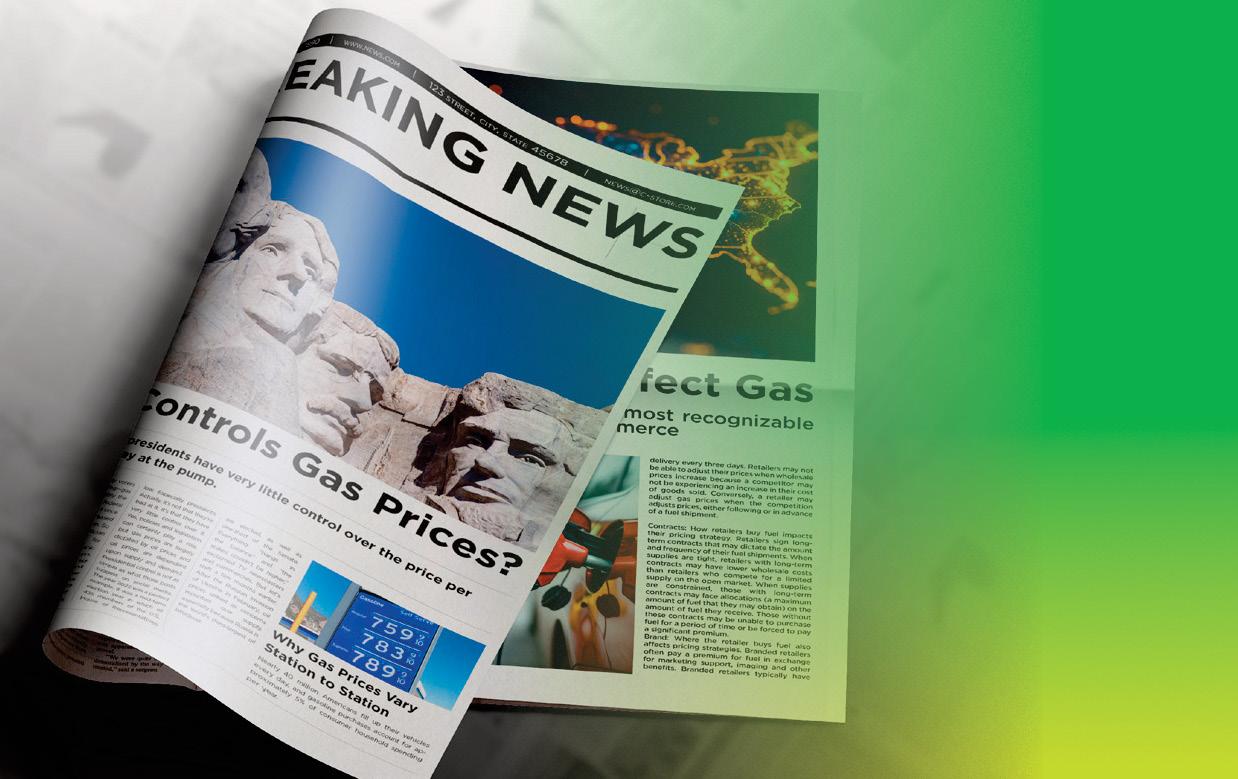
The Best Resources to Explain Gas Prices






Episode #430
Get the inside scoop on all things convenience by downloading our weekly podcast!
If there is one thing Americans can unite on, it’s complaining about gasoline prices. NACS resources can help educate consumers about the industry and correct misperceptions.
Tune in at conveniencematters.com









Combining over 40 years in the industry, our heads of content strategy break down the sources that matter in the world of convenience and fuel retailing.
COMMERCIAL FUELS
Show Hosts: Jeff Lenard & Chrissy Blasinsky, NACS
FuelsMarketNews.com 26 | FMN Magazine SPRING 2024







Your exclusive source of the most up-to-date compensation data for the convenience industry is now available in an interactive, digital tool. The Dashboard is the only convenience-specific HR professional's guide to industry benchmarks on compensation, benefits, recruitment and retention.

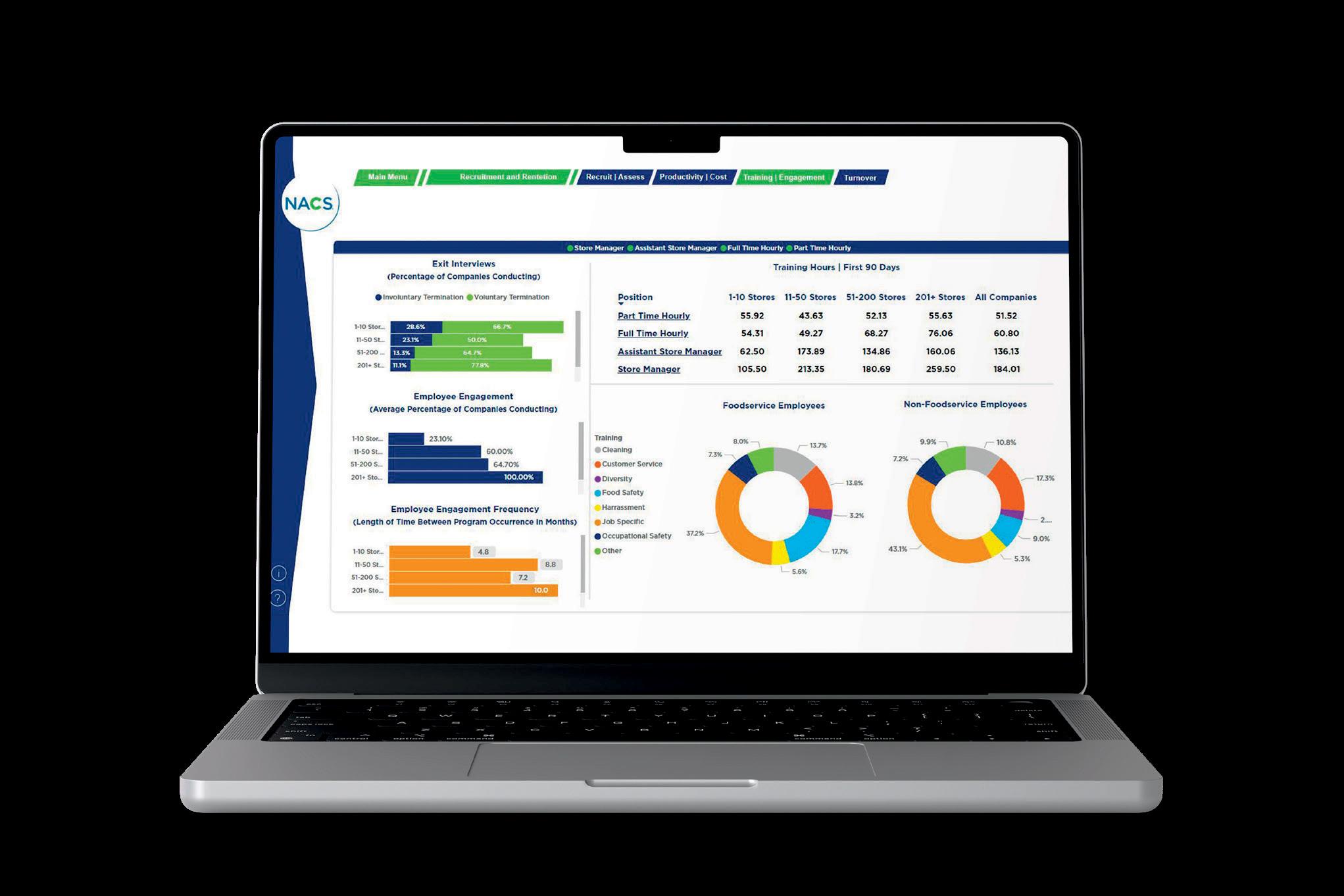


Benchmark against comprehensive, retailer-supplied data to o er di erentiated compensation and incentive programs.

Design a competitive strategy to recruit and retain corporate, operations and store-level personnel.
Build high-performing, e cient teams through insights on screening, hiring and training practices from leading retailers.
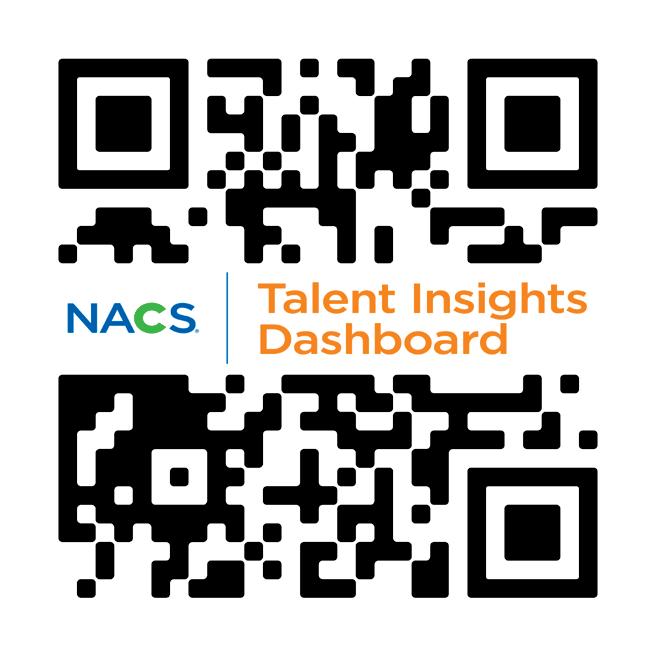


A Generational Issue
When Gen Z joins the family business, different expectations can collide.
BY JOHN KIMMEL
“Life is never boring, because there is always something I can do on my phone.” This is the mantra of the newest, and for many, the most frustrating generation in the workforce. Generation Z seemingly sees the world differently than everyone else, but is there really something unique about Gen Z, or is this just more of the generational differences that have separated the young from the old for all of history?
Nationally, our workforce can be divided into five generations. The Silent Generation, people born between 1928 and 1945, still make up 2% of the workforce. They lived through the Great Depression and WWII, and are quick to remind us of those facts, especially if the conversation we are having
with them revolves around resolve, grit or the unflappable determination that is the hallmark of this group.
Our industry is unique because so many of the petroleum marketers in the United States are multigenerational family businesses. That means that grandma and grandpa, even though they are in their eighties, are still coming into the office. In some cases, they are still the primary decision-makers. They might even sign your check.
Although many Baby Boomers, born between 1946 and 1964, are already enjoying their retirement, about 19% of the workforce falls in this category. Their generation is defined by the first man walking on the moon and the Vietnam War. While in many ways this generation rebelled against the idea of living their lives the same way
that their parents had done, when it came to work, they were very much the same. Hard work, long hours and dedication to family are what make the Boomers tick, and they are quick to let you know if you ask for a three-day weekend or to leave the office early on a Friday afternoon.
Generation X, or Gen X for short, were born between 1965 and 1980, and they represent about 35% of the workforce. While the Cold War and MTV certainly had an impact on this generation, when it comes to the workplace, two factors were very different for them. First, women in the workplace were no longer an anomaly, it was the norm. Second, divorce was becoming common.
For those of us in Gen X who grew up in a family business, it often meant going to work at a very early age. Ironically, when we got old enough to start having children of our own, we were much softer on discipline than the generations that had come before us. Think time-out instead of spanking with a belt. We also started a new trend, where our children did not come to work as young as we did. Some Gen X parents even waited until after high
FUEL MARKETERS YURI_ARCURS/GETTY IMAGES
FuelsMarketNews.com 28 | FMN Magazine SPRING 2024
school or college to introduce their kids to the business.
That leads us to Generation Y, a.k.a. Millennials. Born between 1981 and 1996, they are the largest group in the workplace at 39%. If any one factor shaped this generation, you could make the argument that it was the rise of social media. In addition, something very different occurred socially with this generation.
For centuries, young people had always wanted to be different than their parents, and a little rebellion was normal, especially in the teenage years and in the early twenties. Even so, the older each generation became, the more they acted like their parents. For example, while it was not unusual for an 18-year-old to say they wanted to travel the world and remain single forever, it was equally as unusual for that same person not to have settled down and started a family just a decade or two later.
With Millennials, this didn’t happen. While getting married and having children was almost universally considered as necessary to live a fulfilling life by the Silent Generation, only 15% of Millennials feel the same way. This underlying philosophy created a shift in how Millennials view work. No longer are 60-hour weeks necessary to provide for a family, as fewer hours can provide for an individual.
The newest and smallest segment of the workforce is Generation Z. Born between 1997 and 2012, they are already over 6% of the workforce. This group of people does not remember a world without smartphones, and texting is at least as common for them as talking face to face. Due to the influence of social media and a digital educational environment, these young people are less likely to embrace the political and social standards of their local geography and are more likely to have adopted a more global view of the world, and this includes the workplace. It is now commonplace for a 20-yearold in Cleveland to point to the number of hours the average person works in
Western Europe as an argument to work fewer hours here in the United States. In a report released just a couple of months ago, the average Gen Z worker was working only 29 hours per week, and not trying to increase that number. Additionally, Gen Z workers expect more of what they refer to as work-life balance.
Here is where the situation gets very complicated. If you ask a 60-year-old what work-life balance means, you are likely to hear something like making sure that you have a work schedule that allows you to see some of your kids’ school activities from time to time. Essentially, this generation sees work as the primary activity that adults engage in until they retire.
Personal time is a coveted bonus. Generation Z views the world from a completely different angle. They believe that the primary activity that adults engage in is personal in nature, i.e., whatever makes them happy. Work is something that one does just enough to live whatever lifestyle that person desires. I was recently interviewing an employee for a petroleum marketer who called her supervisor a slavedriver because the boss expected this young lady not only to work for 40 hours per week, but insisted that she do it in the office instead of doing the work remotely.
One can imagine how this kind of attitude can cause a problem when grandfather and grandson are having a conversation about work expectations in the family business. Keep in mind that all these illustrations are generalizations, of course, and there are always exceptions to the rule.
The biggest idea that I hope you take away from this article is that the underlying motivation for people in the workplace has changed, as have the expectations. If you want to have clarity and understanding about what each team member is responsible for delivering, then your business will need to learn to communicate differently to different team members, based at least partially on their age.
These young people are less likely to embrace the political and social standards of their local geography and are more likely to have adopted a more global view of the world.

FUEL MARKETERS
John J. Kimmel is the author of Selling with Power . Kimmel provides custom solutions to increase the effectiveness and profitability of sales teams for petroleum marketers all over the United States. Visit www. johnjkimmel.com
FuelsMarketNews.com FMN Magazine SRPING 2024 | 29
BRAND IN FOCUS: SHELL

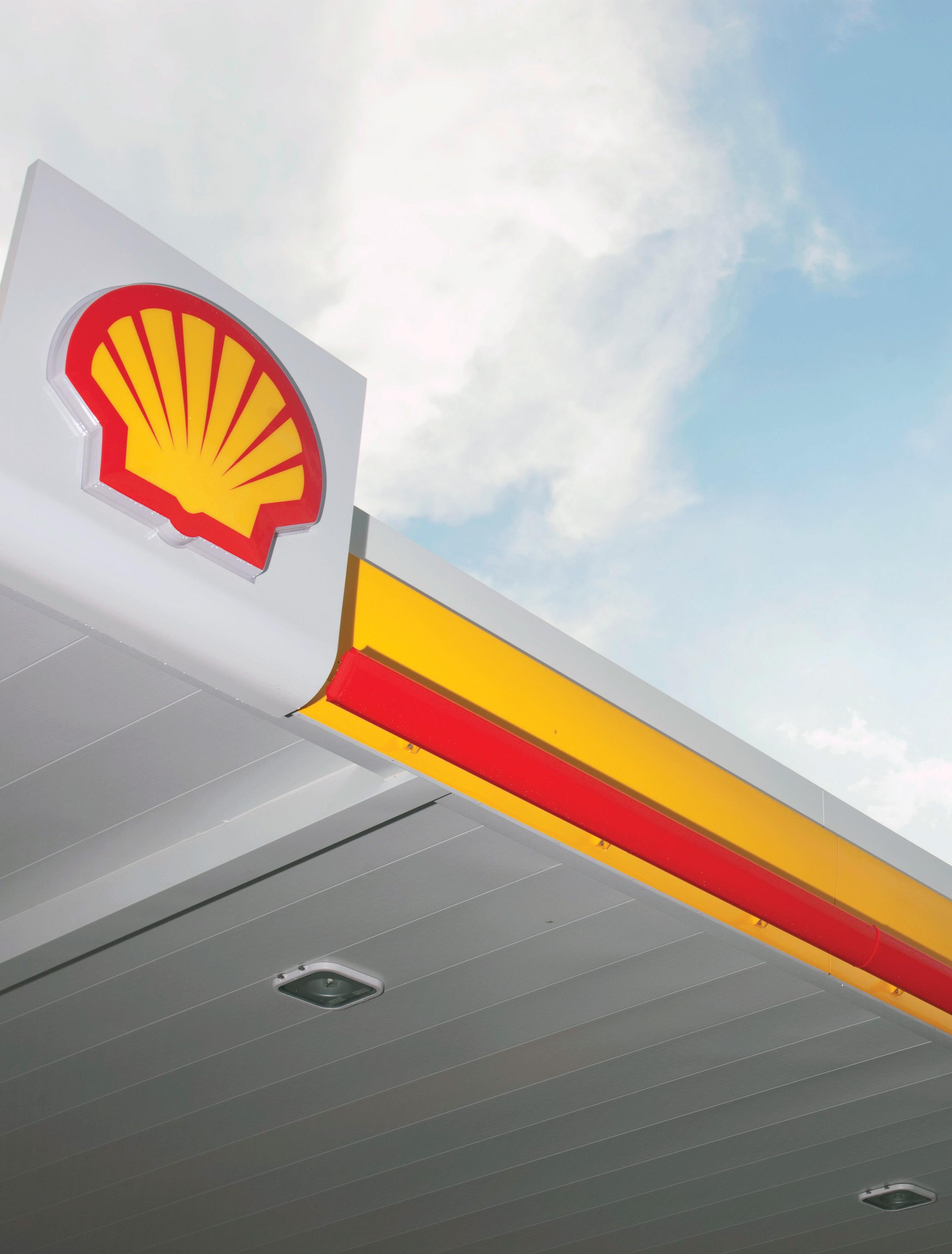 By Keith Reid
By Keith Reid
FuelsMarketNews.com 30 | FMN Magazine SPRING 2024

Three major initiatives drive value at retail.
Shell began as an antiques business in London. Marcus Samuel expanded the shop in 1833 to include seashells, popular in interior design at the time. In the 1880s, his sons took over and entered the oil exporting business.
Today, the company’s downstream operations serve around 32 million customers a day at 46,000 service stations (approximately 12,000 Shell-branded fuel stations in the United States) and provide products to more than a million business customers across 160 countries.
Shell is currently focusing on three main initiatives centered on retailers and wholesalers. “We started to focus on these initiatives starting in 2020 but we really brought them to life in 2023,” said Barbara Stoyko, senior vice president, Shell Mobility Americas. “We call them ‘must wins.’ The way we look at that is how do we win nationally as a brand and product, and how do we make sure that our wholesalers and our retailers win in their markets? Really compete with whoever their top competitors are and be successful with the consumer because they have Shell.”
The initiatives—which focus on fuels quality, loyalty and technology—are deployed nationally, but really have local impact and can also be customized to add even more impact.
FUELS QUALITY
Shell launched a major campaign in 2023 called Performance Unbound, which focused on fuels performance.
“We find in our consumer research that fuel quality remains very important. We have several different customer segments that we go after. Some rank fuels quality as the most important brand issue,” Stoyko said. “We call these the ‘road warriors’ who are primarily focused on premium fuels and premium experiences. We are also working to tap into the younger consumer base and not just the mainstream users, and that is where you tend to find many of the road warriors.”
She noted that road warriors really care about fuel quality because they invest in their cars and tend to value performance. The cars don’t just sit in the garage waiting for the weekend but tend to be daily drivers. As noted, many are relatively young, in their twenties and thirties. In an interesting marketing twist, Shell has developed a relationship with the online gaming platform Fortnite to develop its own game using the Fortnite platform.
More broadly, many of the high efficiency engines today have high compression and require premium. “You’re starting to get a customer base that understands that, and Shell V-Power NiTRO+ is the way that they can make sure that they’re protecting their cars and getting the most performance out of them,” Stoyko said.
LOYALTY
Stoyko pointed out that PDI’s Fuel Rewards loyalty program, which is used by Shell, has over 25 million members and has reached nearly 30% penetration among its customer base.
FuelsMarketNews.com FMN Magazine SPRING 2024 | 31
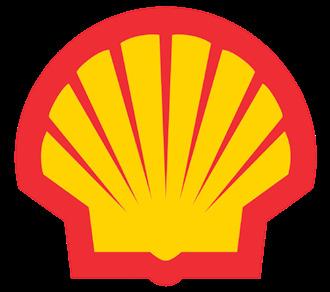

“The loyalty program has been a huge strength for us,” said Stoyko. “We have a number of big elements we recently launched, and I really want to see them come to life and be impactful for our retailers and for our consumers.”
For starters, in addition to the silver tier’s threecent discount and the gold tier’s five-cent discount, there is now a platinum tier with a 10-cent discount. Offerings can be stacked from such companies as T-Mobile, GrubHub and American Airlines. They also put money on the table that can be converted into cents-per-gallon, and a lot of consumers can come in well over a 10-cent-per gallon depending on what they have purchased over the last month. A retailer can set it up so
a lot more flexibility in the way site systems are managed and developed and the way offers are pushed into the point of sale,” Stoyko said. “We are now launching the next version of that, Shell Edge Pro, which we think is on the cutting edge and ahead of our competition.”
She noted that it increases flexibility, allows offers to come to market more rapidly and provides more customization of different store offers while being faster. “That’s important to consumers who are looking to just fuel up and get on their way,” she said.
Shell Edge Pro is a modular technology with a focus on long-term reliability, which Stoyko noted is the primary concern for retailers. The modu-
“The loyalty program has been a huge strength for us. We have a number of big elements we recently launched, and I really want to see them come to life and be impactful for our retailers and for our consumers.”
every time a customer spends $25 at the store over a period of time, not just one occasion, they will get another number of cents in their basket.
The program also comes with convenience store offers.
“We don’t have our own invested network across the United States, but we do put together c-store offers because that’s important for both consumers and retailers,” Stoyko said. “The loyalty program allows them to put offers on the table that stack on top of our offers. For example, we’re one of the largest buyers of Red Bull in the world. They’ve come to the table with some great deals—a certain cents per gallon if you buy two Red Bulls, etc.”
The program builds on continuity, so it doesn’t have to be the same purchasing opportunity. It can track purchases through a customer’s loyalty program ID.
TECHNOLOGY
“I think we led the industry 10 years ago when we launched Shell Vantage. That was the first-to-market electronic payment solution (EPS) that allowed
lar design with the move to EPS allows for rapid customization with minimal coding. The first box is provided free to the retailer operator.
“A big push for us this year is to get everybody moved over to Shell Edge Pro, and converting a site is rapid—15 to 20 minutes,” Stoyko said.
EXPANSION
Is Shell in expansion mode for retailers and wholesalers?
“I think we have the best wholesalers and retailers in the industry,” Stoyko said. “We’re really looking to grow with them. We’ve had record growth the last three or four years—well over 200 million gallons a year.”
She noted that Shell is looking to add new wholesalers where there are needs. “In some markets we have wholesalers that really can continue to grow and meet the customer’s needs. In other markets, there’s less opportunity,” she said.
For retail operators, the most important thing is that they can represent the Shell brand and all of the consumer value propositions.
“The worst thing would be to have a consumer
FuelsMarketNews.com 32 | FMN Magazine SPRING 2024

show up and not be able to get all that they expect from the Shell brand,” Stoyko said. “So, what I’m looking for first and foremost are engaged wholesalers that can bring to life a quality experience that matches the quality fuels and maximizes the loyalty program.”
As a wholesaler benefit, Shell offers the Shell Mobility Academy, an extensive training program for site sales staff that teaches them how to leverage the Shell brand at their sites. There are programs in place to support its wholesalers who are seeking dealer business.
Shell also provides incentives for site staff to get customers to scan a QR code or sign up for Fuel Rewards.
“The first time a customer makes a purchase of fuel, the cashier gets $3,” Stoyko said. “That can make a difference. It creates a value proposition for the employee and aligns motivation. Our site staff are so good with people, you give them some tools, give them some training and the ones that are into it will really knock your socks off in terms of numbers. So that’s been fun.”
CARBON REDUCTION
Shell has been one of the major oil companies on the forefront of the carbon reduction push. On the liquid and gaseous fuels front, the company offers E15, E85, renewable diesel, biodiesel, hydrogen and other offers on a market-by-market basis.
“Whether they want traditional fuels, renewable fuels or EV charging, I want our customers to get what they need from Shell,” Stoyko said. “We have 25 million people in our loyalty program, the number one position in market share and brand share preference. So how can we transition them from where they are today to where they’re going tomorrow and not give them a reason to go look elsewhere?”
She noted that Shell is making a lot of investment on the EV front.
“We’re probably making more investments than most other majors in that area because I want to make sure that when the customers are ready, we have a super strong commercial offer to provide to the consumer and the retailer.”
She noted Shell is making preliminary investment at retailer locations, showing them how it works and observing what the demand is in markets. Shell is researching EV consumer shopping behavior and is exploring how to integrate EV
customers into the company’s loyalty strategy.
“Most people are going to have one of each car in the short term, and so even between fuel and EV a given customer may go back and forth,” Stoyko said. “As I noted, I don’t give a customer a reason to go anywhere else, but I also want to make sure that retailers feel like they have what they need if they’re in a market that’s moving quickly. So, we’re really focusing on the markets that are really outpacing the others in terms of EV demand.”
COCO SITES
In 2022, Shell signed an agreement to acquire 248 fuel and convenience retail sites from the Landmark group of companies, whose convenience stores operate in Texas under the Timewise brand. The agreement also includes supply agreements with an additional 117 independently operated fuel and convenience sites. Of these, 172 are company owned, company operated (COCO) and 12 are company owned, retailer operated (CORO).
In February 2024, Shell signed an agreement to acquire 45 fuel and convenience store sites in New Mexico through the acquisition of Brewer Oil Company’s (BOC) retail division. BOC and Shell have had a long-tenured relationship, with BOC acting as a Shell wholesaler since the 1970s.
What motivated the return to company-owned, company-operated sites?
“Having a core network of company operated locations can be beneficial,” Stoyko said. “In the big picture, with the energy transition, we are really setting ourselves up for success over the next 20-30 years. It provides us with a more integrated margin picture versus just fuels. So, we get a portion of our businesses coming from a business that has retail margin, store, car wash, those things.”
Stoyko noted that it doesn’t detract from Shell’s traditional wholesale and retail relationships. In fact, this provides Shell with a test bed for new retail concepts and operational initiatives.
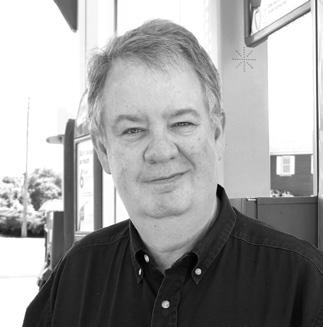
Keith Reid is editor-in-chief of Fuels Market News. He can be reached at kreid@fmnweb.com
FuelsMarketNews.com FMN Magazine SPRING 2024 | 33
ENERGY AND EQUITY
By Keith Reid
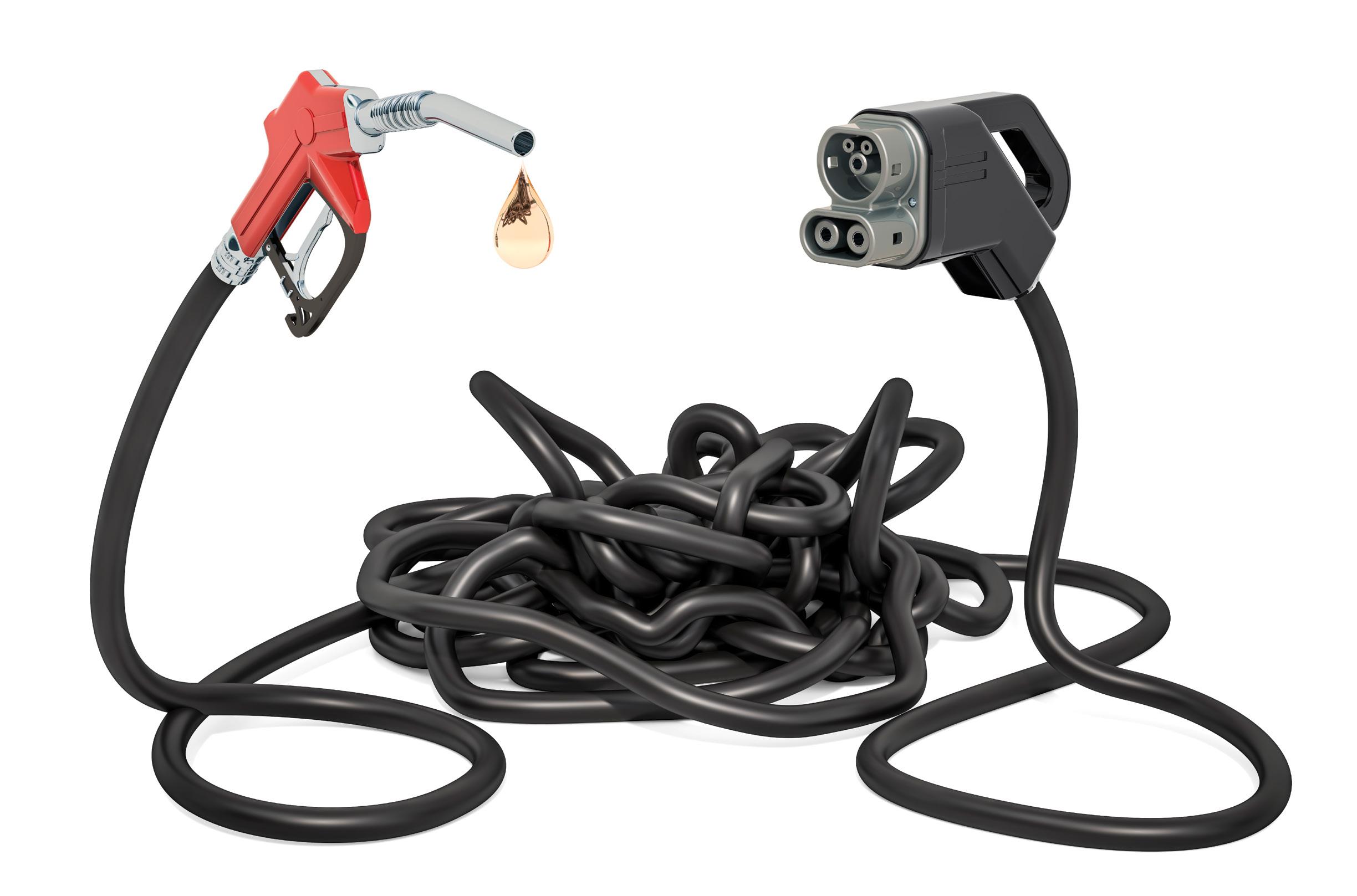
FuelsMarketNews.com 34 | FMN Magazine SPRING 2024
The push for decarbonization is leaving some communities behind.
People complain when the price of a gallon of gasoline spikes and filling the tank results in a shocking total. And in states such as California, that amount can take your breath away. However, our current energy infrastructure overall is mature, stable and objectively inexpensive.
Moving to net-zero carbon is a disruptive process, one that invariably brings with it higher energy costs, at least in the short term. Renewables for electricity generation, electric vehicles (EVs) and low-carbon renewable liquid fuels are markets largely in their infancy. It’s going to take time before they become mainstream, and costs decrease.
Current energy prices are hard enough on the most disadvantaged communities, but prices during a transitional period for low-carbon solutions will likely exceed current energy costs barring aggressive government supports, leading to gaps in service and availability. So, what are
the dynamics of the issue, and what can be done?
Keeping to its charter, the Transportation Energy Institute (TEI) recently developed a white paper “Transportation Equity” prepared by Transport Energy Strategies. We’ll highlight some of the findings here, as well as cover some additional areas.
“Lower emissions strategies and policies need to consider all stakeholders and ensure everyone can participate in the energy transition,” said John Eichberger, TEI director. “The bottom line is that not every solution being considered is appropriate or applicable to all communities. Lower income and remote, rural communities may not be able to support a transition to EVs, but they should not be left behind due to this fact—they need to be given the opportunity to improve their transportation economics and emissions just like more affluent and urban communities. Policies that do not reflect these differences between communities are short-sighted and could result in trapping communities in the past.”
FuelsMarketNews.com FMN Magazine SPRING 2024 | 35
Transportation equity, which has its roots in the environmental justice (EJ) movement, is not a new concept, and in fact, has bipartisan roots. EJ developed in the early 1980s over PCB contamination in largely Black communities. President George H. W. Bush established an environmental equity working group in 1992. Further efforts were undertaken during the Clinton administration, and such efforts are a cornerstone of the Biden administration.
As the white paper notes, according to the U.S. Department of Transportation (DOT), equity in transportation: “[S]eeks fairness in mobility and accessibility to meet the needs of all community members. A central goal of transportation is to facilitate social and economic opportunities by providing equitable levels of access to affordable and reliable transportation options based on the needs of the populations being served, particularly populations that are traditionally underserved.”
While the current focus on transportation is centered on cost and availability, health concerns such as air quality issues remain important.
WHAT IS A DISADVANTAGED COMMUNITY?
DOT has a list of factors that go into categorizing a disadvantaged community (DAC), but it can be generally summarized as a population with high poverty, low wealth, lack of local jobs, low home ownership, low educational attainment and high inequality. There are a variety of tools that have been developed to help identify these communities throughout the United States.
Among initiatives President Biden put into effect through executive order and legislation is Justice 40, which, as the white paper notes, directs significant federal investments to communities with a history of disinvestment or discrimination that bear a disproportionate share of environmental and climate-change-related burdens.
Convenience stores and truck stops provide the base of the transportation fueling infrastructure. Are DACs typically served by large c-store retailers or by mom-and-pop type operations? How does that affect charger support?
“Urban areas may have branded and unbranded c-stores serving these communities,” said TEI Vice President Jeff Hove. “These businesses generally have a very small footprint, which impedes charger deployment. Rural c-stores are often single-owner stores, with some notable exceptions, that do not have a high level of capital for investing in a new fueling option.”
EVs AND EQUITY
The white paper focuses heavily on the issues related to EVs in the transportation equity discussion. The reason is simple, as governments throughout the world have looked to EVs as the zero-carbon solution. And various states in America have regarded EVs as not only a primary solution but, in many cases, the only transportation solution to carbon reduction.
The white paper, citing the National Resources Defense Council, notes: “Currently, most of the nation’s public chargers remain clustered in areas where wealthy, predominantly white, early EV adopters live. That’s not altogether surprising, given charging station developers went where there was demand. But this has also created areas with little to no public charging access that often fall along racial and socioeconomic lines.”
EV technology has advanced considerably. These vehicles represent a viable and often mainstream transportation option for large sections of the motoring public, regardless of carbon concerns. However, there are challenges that remain—primarily related to the availability of chargers and the cost of EVs that can be particularly significant in disadvantaged communities.
“With regard to infrastructure, large [retailers] have economies of scale to invest in new tech, whereas many mom-and-pops do not,” Eichberger said. “This situation is exacerbated by the EV transition. Stores in heavily urban markets often have very small formats, typically traditional gas stations with no room for anything else. Rural stores tend to have more space, but they also don’t have the throughput required to sustain an EV investment, and rural drivers currently are not your typical EV driver.”
What about the grid? This is an area of concern in the broader discussion of EV expansion (and more recently the expansion of AI development), so how will that play out in these DACs?
“The health of a grid is as much a product of the utility servicing the community as it is the nature of the community,” Eichberger said. “A rural co-op could be very well-funded and operate a very modern system, whereas a public power agency in a deeply urban market may be functioning on an antiquated system without the resources to invest in modernization. Markets, and the servicing utilities, need to be assessed independently and not simply categorized based upon certain criteria.”
The Biden administration has been making efforts to expand charger infrastructure through such programs as the Infrastructure and Investment Jobs Act’s NEVI program,
OPENING SPREAD: ALEXLMX/GETTY IMAGES FuelsMarketNews.com 36 | FMN Magazine SPRING 2024
“Lower emissions strategies and policies need to consider all stakeholders and ensure everyone can participate in the energy transition. … Not every solution being considered is appropriate or applicable to all communities.”

which will direct $5 billion over the next five years to help build 500,000 EV chargers across the country. However, much of this focus is on major transportation arteries. As the white paper notes, the complementary Charging and Fueling Infrastructure Discretionary Grant Program set aside an additional $2.5 billion for EV charging, hydrogen, propane and natural gas fueling infrastructure with a focus on rural and underserved communities that might otherwise be overlooked.
There is more nuance at work than just randomly adding chargers, and the convenience store industry can be a leader in these areas.
“Urban area EV charging development must include a level of community improvement to create safe areas where EV owners feel comfortable charging for 20-plus minutes,” Hove said. “Public safety is a growing concern, and if done correctly, the c-store can greatly improve the community environment. What’s good for the community is good for the business. Likewise, urban and remote disadvantaged communities have their own special set of wants and needs that the c-store operator can meet, as long as the business proposition/model can be built around the plan and yield acceptable revenue.”
Then there is the cost of the vehicle. Prices are coming down, but the price difference between
a new EV and a new ICE vehicle can be as great as $16,000. Similarly, there are issues with the availability of EVs in the used vehicle market and some concerns over the impact of battery life with aging vehicles.
“The used EV market is growing, and I get a sense that resale value, for an EV, is generally less than that of an ICE,” Hove said. “This is likely due to fears of EVs no longer being under warranty and [because] the prospects of potential battery replacement create a consumer fear. However, I have seen no data that supports a timeline for battery replacement. EVs are relatively new to the market [under 15 years], and there are so many factors that can affect battery life that it is difficult to accurately predict when a battery might need to be replaced.”
LOW-CARBON LIQUID FUELS
Electrification is not the only technology available to get carbon out of transportation. Despite less focus, e-fuels and high renewable content fuels present an alternative that allows the use of the existing fueling infrastructure.
However, these solutions are in the early stages of development, resulting in high prices compared with current fossil fuels (without various price supports in place in regions such as
EUCYLN/GETTY IAMGES FuelsMarketNews.com FMN Magazine SPRING 2024 | 37
the West Coast and the Northeast). Renewable diesel can cost as much as $4 per gallon more than petroleum diesel, without low carbon price supports. E-fuels are currently at least three to four times as expensive as gasoline. However, prices are dropping steadily, and supplies—especially with renewable diesel— are expanding. And despite what seems to be a frantic push for extreme, short-term carbon reductions, conventional petroleum fuels and combustion will be in the market for decades to come. There are opportunities with reasonably priced bio and renewable blends that let internal combustion vehicles emit far less carbon during their time on the road. And ultimately,
zero-carbon initiatives are just starting to affect consumers in tangible ways. The outcome of these natural markets and political forces has yet to play out.
Further, residential electricity is currently “cheap,” at about half the price (compared with gasoline) to keep a car on the road for a month. Public fast charging, however, with issues such as demand charges, can offset this price advantage at the retail site. It is also worth considering that the impact of requiring that all electricity be generated by renewables has yet to play out. Renewable leader California currently has electricity rates that are roughly double the national average. Supporters say that these costs are
Addressing Transportation Equity
By Victoria Flowers
Putting grid and EV range limitations aside for a moment, there are two additional difficult EV realities that leaders and transportation energy providers need to address: Not every consumer in the United States will be able to afford an EV, and not every c-store operator will be able to afford to add EV charging to their facility.
If left unchecked, these two factors will not only compromise transportation equity in low-income areas, rural communities and Indian Country, they will also slow decarbonization.
Fortunately, a proven solution already exists that will help bridge transportation and decarbonization needs. Here’s what every c-store operator needs to know about the connection between transportation equity and the future supply of transportation energy.
OUT-OF-REACH COSTS
EVs cannot be expected to serve all light-duty transportation needs across the U.S. socioeconomic spectrum. Why? For starters, EVs are expensive.
Although a lot of factors influence vehicle pricing (supply, demand and inflation, to name a few), EV prices were about $16,000 higher than prices for internal combustion engine vehicles (ICEVs) in 2022. The average cost for a new ICEV was $46,000, while an EV cost about $61,000.
While the market for used EVs is beginning to mature and used EV prices have dropped, they are still steep—the average price being almost $28,000. For perspective, the federal poverty level was set at $30,000 for a family of four in 2023, and 11.5% of people were
living in poverty in the U.S. in 2022.
On the business side of things, the costs to add EV charging will be too much for some operations to absorb. The business case for adding EV charging simply will not be justifiable in all cases. Beyond the charger investments, which are substantial on their own, soft costs associated with implementing the infrastructure can quickly make an EV project financially unfeasible.
FLAWED DECARBONIZATION APPROACH
Beyond the financial barriers, it is worth noting there are substantive flaws in a transportation decarbonization plan that relies on EVs.
First of all, the turnover of the vehicle fleet continues to slow. The average lifespan of a vehicle is on the rise due to improvements in engineering quality. Light-duty vehicles are typically on the road for 15 to 20 years, with some of them lasting upward of 25 to 30 years. Think about that—vehicles are lasting as long as USTs!
The current goal is for EVs to comprise 50% of all new vehicle sales by 2030. While that goal is well-intentioned, EV sales are highly unlikely to hit the target. An S&P Mobility Report states that as of Oct. 31, 2022, EVs accounted for only 0.7% of the 281 million vehicles in operation. Even the U.S. Energy Information Administration has projected that, under a scenario where buyers may be motivated to purchase EVs in response to high gasoline prices, EVs will account for less than a third of car and truck sales through 2050.
And let’s face facts: Americans still like their ICEVs.
FuelsMarketNews.com 38 | FMN Magazine SPRING 2024
rapidly dropping and that the long-term savings will be worth the short-term pain.
Alternatively, conventional ethanol and bioand renewable-blended conventional fuels can provide significant carbon reductions today throughout the vehicle fleet, both in DACs and more broadly—and at far more competitive prices. The DACs in states such as California may not have this opportunity given current policies, but those in other regions likely will.
“If the goal is to successfully reduce carbon and air pollutant emissions while serving the needs of all communities, we need policies that support innovation and promote realistic, affordable solutions,” Eichberger said. “For
decades, scientists and engineers have found solutions to our most daunting challenges— we need policies that enable them to continue doing so, whether those solutions are powered by electricity, liquid or gaseous fuels. We can and should strive to achieve our environmental objectives in a way that preserves access to affordable and reliable transportation energy for consumers in all communities.”
in the Age of EVs
Although sales of EVs are increasing, the top three selling vehicles in the U.S. in the first three quarters of 2023 were, in fact, all full-size ICE pick-up trucks.
LIQUID FUELS TO THE RESCUE
As the vehicle fleet stands now, ICEVs powered by cleaner-burning liquid fuels are having a greater impact on greenhouse gases than EVs.
A real-world example of this is demonstrated through California’s Low Carbon Fuel Standard, which quantifies greenhouse gas reductions in vehicles powered by alternative energy sources. This includes both zero-emission vehicles and vehicles powered by biofuels. In the third quarter of 2023, the program’s cumulative greenhouse gas reductions broke down like this:
• Biofuels: 83%
• Zero-emission vehicles: 16%
Criteria pollutants—air pollutants for which acceptable levels of exposure can be determined—tell a compelling story because there are parallels between the success of criteria pollutant reduction in ICEVs and reduction in greenhouse gas emissions in those same vehicles. Since 2000, the NOx emission rate from gasoline cars has been reduced by 92%, and by 2030 this rate is projected to be 98% lower than the 2000 baseline.
CONCLUSION
To ensure both equitable mobility and meaningful decarbonization, the U.S. transportation energy
portfolio must include liquid fuels for the foreseeable future. As such, fuel retailers need to continue preparing their operations to store and supply cleaner burning fuels.
However, it would be foolish to ignore EVs altogether. Taking care to phase in EV infrastructure when opportunities arise—such as stubbing in charging ports when breaking concrete for underground fueling system upgrades—can help spread EV costs out over time. And if EVs do become ubiquitous regardless of socioeconomic factors, forward-thinking transportation energy retailers who prepared ahead of time will be in the best position to serve the energy needs of their community.

Victoria Flowers is a Tribal UST and Environmental Compliance Coordinator for a Tribal Nation and a consultant supporting tribal environmental programs. She has over 30 years of experience and leadership and is recognized nationally among her peers as an expert in tribal environmental program development and management, CERCLA 128(a) Brownfield Programs and underground storage tank compliance in Indian Country. Contact her at vflowers326@gmail.com or (920) 366-6720.
FuelsMarketNews.com FMN Magazine SPRING 2024 | 39
IN THE LEAD: CONEXXUS
By Keith Reid




















































































































































































FuelsMarketNews.com 40 | FMN Magazine SPRING 2024
Unified standards help the industry move from proprietary to open solutions.

“T
GRAY TAYLOR EXECUTIVE DIRECTOR, CONEXXUS
hey say God made man, but Sam Colt made them equal.” This quote referenced the original Colt Single Action Army revolver and how it leveled the playing field in the Wild West. Technology does the same for convenience retailers and petroleum marketers. A large operation has a lot of advantages with economy of scale. A small operation has advantages like flexibility. But the efficient use of technology can greatly level the playing field in both directions, addressing shortcomings and amplifying advantages.
Conexxus (originally PCATS) was created as an offshoot of NACS as a non-profit, member-driven technology organization dedicated to the development and implementation of standards, technologies innovation and advocacy for the convenience store and retail fueling market. Conexxus membership collaborates on key present and future industry challenges and innovations. Its efforts improve profitability by reducing the cost of IT ownership and improving the competitiveness of its members.
Fuels Market News Magazine interviewed Gray Taylor, Conexxus executive director, for a rundown on the organization and how it supports the industry.









































































































FuelsMarketNews.com FMN Magazine SPRING 2024 | 41



































WHAT PROMPTED THE FORMATION OF CONEXXUS?





Back in 2003 the NACS board said technology is interesting, but if the market really values supporting technology development, it would be willing to pay for it independently. NACS is an advocacy organization, and the decision was made that an independent but convenience-focused organization would be most effective for exploring those needs. So, the Petroleum Convenience, Alliance for Technology Standards (PCATS) was born. NACS president and CEO Henry Armour (then a retailer) was one of those who were really driving this.






I was involved from the start while working for an industry technology vendor. I can tell you what my motivations were. We had an excellent POS system, and it controlled all the fuel pumps, but getting a connection to the back office, card readers, networks—those were all huge tasks that were actually more business oriented than technical in nature. Back then, it was tough, as all the solutions tended to be proprietary. We’re used to plug-and-play today but that was not the case with industry solutions unless the solutions were from the same companies. It was a major IT project to link things together, and retailers were looking for solutions that would easily allow them to bring other systems online.
To the credit of the vendors in the industry, they all stepped up and said, my core business is POS, or a back office or whatever. I think my solution is the best, and I would be better off if I could connect more easily to other solutions. So, it was really a matter of necessity from both a retail and a vendor standpoint.
The other thing we realized was that there was no facility within NACS to look at the tech future. Our Conexxus Innovation Research Committee is made up of nothing but retailers, and probably the most successful thing from the committee is the Conexxus Roadmap. It looks at a 10-year horizon and clarifies what retailers are seeing on the horizon. These are areas where the industry can prepare today instead of reacting tomorrow.
WHAT PROMPTED THE NAME CHANGE TO CONEXXUS?
Well, I got tired of my kids laughing at the place I worked at—PCATS. (It did sound funny, if you
think about it.) I started thinking, unless you know what it stood for it doesn’t say anything about what we do. We did a massive rebrand. We brought in a consultant, and that’s where we came up with “Conexxus.” And it’s a play on words obviously—nexus and connections. So, “Conexxus” really summed it all up.
WHAT IS THE ENVELOPE OF TECHNOLOGIES AND SOLUTIONS THAT CONEXXUS COVERS?
The best way I can describe it is we’re kind of an opening flower. We focus on the middle of the flower, how a fuel dispenser talks to a POS which talks to a back office and the stuff that is contained within the store. We’re working on external connections. As an example, one of the things we’re working on is how do we facilitate third-party delivery in an integrated fashion that enhances customers’ experience.
WHAT HAVE BEEN SOME OF THE ORGANIZATION’S MAJOR ACCOMPLISHMENTS?
Probably our major accomplishment is we did the first mobile platform, and I don’t know of anybody else who’s come out with mobile payments. We had that around 2016, and that’s the standard used by most of the major oils.
Another major accomplishment would be our loyalty interface, which saw its first version back in 2010. And we’re adding new products. The industry will be able to take the new version of digital coupons that are fraud proof. That’s an infrastructure that the big box and the drugstore guys are going with, and our standard has held up so well that we’re using that standard to take those coupons. That’s going to allow the industry to accept over $300 billion worth of new coupons.
We’re actively working on what we call a data dictionary, which sounds dry, but as we got into enterprise and disparate systems, we needed to define things like what a fuel sale was. We’re up to about 800 definitions.
IS THERE ANY RETAIL CROSSOVER BEYOND THE CONVENIENCE SECTOR?
We’ve got some overlap with the independent grocery stores. They’re not convenience stores, but they have huge inventories, and they also sell fuel. They sell a lot of fuel. So, we’re seeing some work there with the POS. A lot of people are just

















PREVIOUS SPREAD AND THIS SPREAD: BERYA113/GETTY IMAGES FuelsMarketNews.com 42 | FMN Magazine SPRING 2024










































coming in to work with our forecourt standards. We have reached out to chain drug and we’re actively reaching out for a deeper relationship with the smaller independent drug, grocery and dollar stores.
YOU HAVE A MIXED BOARD WITH THE RETAIL SECTOR AND THE VENDOR SECTOR. WHAT ARE THE BENEFITS THAT MODEL BRINGS TO THE TABLE?
The original premise—which remains—is everybody joins and participates as an equal. The only place where retailers play exclusively is the retailer business requirements (RBR) committee. As a former vendor, that is valuable because that committee is the voice of your customer. You can pitch a standard, but it must go through the RBR, which is the first litmus test as to whether the industry’s going to buy it. So, if you pitch something and they turn it down, then you’re probably better off going back and reevaluating that product. So they’re kind of gatekeepers. But every other thing can be led by a vendor. And it’s interesting, because the vendor-customer relationship tends to drop off when they’re in committee work.
DESCRIBE THE
PROCESS, FROM
WHEN SOMEBODY PROPOSES A STANDARD UNTIL YOU’VE SIGNED OFF ON IT.
A proposed standard would be presented to the appropriate committee. Let’s say that we wanted to support a standard for Internet of Things around an HVAC system. That would go to the device integration committee. And that committee would come to a consensus that this is something we wouldn’t mind working on over the next 12 months. We have some other things, such as a checkoff of the data security committee to make sure that we’re not creating a standard that creates a data or security problem. And then that is presented to the RBR. If the RBR says yes, you come in with a business requirements document and those types of things and then the committee can take that over. It works closely with the standards quality assurance (SQA) group so that every standard is consistent in format.
HOW DOES THE CONFLICT RESOLUTION PROCESS WORK IN THE PROCESS?
First, if it doesn’t pass RBR, that doesn’t keep a
vendor from moving ahead and coming up with a proprietary interface. If it makes it through RBR, it’s very much like Congress. There’s a lot of debate and they figure it out. And if it doesn’t get figured out, it doesn’t make it out. The sausage making can be easy. It depends on if everybody agrees with the use cases upfront. But it can also be difficult. One of the things that we really protect, and where potential conflict can arise, is companies that come in inadvertently with intellectual property. We’ve never had anybody successfully do that, because in our bylaws you give an automatic grant to all Conexxus members.
We’re used to plug-and-play today, but that was not the case with industry solutions unless the solutions were from the same companies. It was a major IT project to link things together.
WHAT TYPE OF RETAILERS ARE YOU LOOKING FOR?
We’ve got a sliding scale membership, and you can be a gold, full voting member with equal rights to the largest chains for $1,600 a year. What we’re really looking for is input. I don’t care if a person isn’t a technologist. In fact, we have lots of technologists. What we really need are people who have a pain point and can express it so it can be addressed.
We need your support. So, join, support Conexxus and get your voice heard and your problems solved.

Keith Reid is editor-in-chief of Fuels Market News. He can be reached at kreid@fmnweb.com
FuelsMarketNews.com FMN Magazine SPRING 2024 | 43
A FAMILY AFFAIR
Founded in 1988 by three brothers, the company has grown as a full-on family business.

 Kaylie Long Scoles Marketing director RDM Industrial Electronics Inc.
Kaylie Long Scoles Marketing director RDM Industrial Electronics Inc.
Three brothers started the company in 1988 rebuilding gas pumps. Now, RDM is a source for both new and remanufactured petroleum equipment and has grown to six locations and 150 employees with the first and second generation of family heavily involved.
HOW DO YOU BALANCE THE FAMILY RELATIONSHIP DYNAMIC WITH THE PROFESSIONAL BUSINESS DYNAMIC?
When family and business is intertwined, it’s important to set boundaries to keep things professional while at work and keep things fun outside of work. At the end of the day, we all have the same idea of success: providing jobs to our community and being the best stewards of the business that we can be. With the same mission, balancing the dynamic becomes easier.
IF FAMILY MEMBERS WANT TO BE PART OF THE BUSINESS, HOW DO YOU INTEGRATE THEM INTO THE OPERATION?
Even though we spent summers and school breaks working at RDM, there was never pressure
for us, the second generation, to join the family business after college. We each decided to work at RDM on our own. Making that choice personally made me feel more invested in the company than if I had been pushed or convinced to do it.
I think it is very important to avoid inserting family members directly into management roles when they join the team. Allowing family to work their way up through the organization naturally allows for the family member to learn other aspects of the business, creates a more diverse view of the company and allows them to earn trust from coworkers and authority figures.
It is also vital to implement family members where their strengths and education is aligned with the job duties. Our owners have always been very good about allowing the second generation to grow into their roles and passion— to figure out our strengths and to do more of what we enjoy doing at work. They want our work to be as fulfilling for us as it has been for them—”find a job you enjoy doing, and you will never have to work a day in your life” (Mark Twain).
FuelsMarketNews.com 44 | FMN Magazine SPRING 2024
HOW DO YOU MAINTAIN COMPANY MORALE, BUY IN, MOTIVATION AND DRIVE WITH NON-FAMILY EMPLOYEES?
Communicating company-wide goals and celebrating our accomplishments as a company is vital. RDM has heavily invested in our company culture over the last year so that as we grow, we can maintain the small family business feel. I am confident in saying our family is amongst the hardest workers in the company—work ethic and dedication never go unnoticed. We do our best to inspire and empower all team members to be the very best that they can be so that we can work together to achieve our shared goals.
Our family is fortunate enough to have many incredible employees who believe in both generations of our family business and our mission and work tirelessly to help us achieve our goals.
CAN A FAMILY BUSINESS HAVE ADVANTAGES IN THE MARKETPLACE?
One of the biggest advantages is the culture in which family businesses can create. Values and culture resonate with both employees and customers leading to stronger brand loyalty and a more dedicated workforce.
Our family business also has deep rooted connections within our community and industry. These relationships built on trust and personal connections lead to enhanced customer loyalty, favorable partnerships and access to resources.
Another advantage family businesses like RDM have is their commitment to providing a quality product and service. The family takes great pride in their quality and has their reputation tied to the quality of the products they sell. The RDM reputation is tied closely to the Long family name—something we take pride in and are very careful about.
This commitment to quality gives RDM a competitive advantage in the industry in terms of customer satisfaction and retention
Family businesses like RDM have a succession plan in place to ensure continuity in leadership and strategy across generations. The stability of values and integrity is attractive to both customers and employees. RDM will only build upon the same values that were instilled in us.
WHAT IS THE BIGGEST CHALLENGE WITH A FAMILY BUSINESS?
From my perspective as the daughter of one of the co-owners, earning respect can be more difficult.
Second generation family-members must work extra hard show they deserve respect. It takes time, education and experience. Family members must invest their time and effort.
Resolving conflict with open communication and understanding. It’s perfectly okay to have different opinions, in fact, our leadership embraces diversity in thought processes and decision making. However, once a final solution is reached, working towards our goal together as a team becomes the bigger challenge.
WHAT IS THE BIGGEST ADVANTAGE?
One of the most significant perks is the opportunity to spend time with your loved ones while pursuing your passion. Working alongside family members, like your father in my instance, for an extended period is a rare privilege that I value deeply. Even on challenging days, this bond serves as a source of strength and inspiration.
For non-family members, family-owned companies are more understanding of their employees. They treat employees like they would wish for their family to be treated. Family businesses like RDM can create a healthy work environment with work/life balance, mutual respect and guiding morals and values.
ADDRESSING BIG PICTURE STRATEGIC ISSUES (INVESTMENT, GROWTH, ETC.)
At RDM, we believe in the power of diversity and collaboration when it comes to leadership. It’s not just about family ties; it’s about having a mix of talents, perspectives and experience onboard. Our key employees come from various backgrounds, proving that bloodline is not a requirement for leadership. The next generation brings fresh perspectives that naturally drive growth, while the current owners focus on diversification and shaping a robust company for the hand-off. Together, we reinvest in the company and turn every challenge into a valuable teaching moment.

FuelsMarketNews.com FMN Magazine SPRING 2024 | 45
DOVER ACQUIRES POS PROVIDER BULLOCH TECHNOLOGIES
Dover announced that it has completed its acquisition of Bulloch Technologies, Inc., a provider of point-of-sale, forecourt controller and electronic payment server solutions to the convenience retail industry for CAD150 million, subject to customary adjustments and with additional contingent consideration tied to future growth of the business. Bulloch will become part of the Dover Fueling Solutions operating unit within Dover’s Clean Energy and Fueling segment. Headquartered in Toronto, Ontario, Bulloch is a supplier of POS and related digital solutions and services to the convenience retail industry in Canada, serving many of the largest retailers in the country. The company processes over $35 billion in sales and 520 million transactions annually at 7,000 sites throughout Canada.
D&H UNITED TO OPEN OMAHA BRANCH TO SERVE NEBRASKA
D&H United, a portfolio company of Wind Point Partners, announced the opening of branch operations in Omaha, Nebraska. Starting February 19, D&H United will supply a full suite of fuel system maintenance and repair services. The company is securing a new office which will be the company’s 34th regional location and will further enhance D&H’s ability to serve clients in Nebraska. The expansion comes on the heels of the recent announcement that Gilbarco Veeder-Root has awarded D&H United the rights to distribute and service Gilbarco Veeder-Root petroleum equipment throughout the state.
EQUIPMENTSHARE NEW THUNDER CREEK DEALER
Thunder Creek Equipment, a manufacturer of innovative and premium fueling and preventive maintenance solutions, has introduced EquipmentShare as its new dealer of its product sales and support lineup at locations in Columbia, Missouri, and Oklahoma City, Oklahoma. Thunder Creek Equipment designs and manufactures products that are used in a variety of industries including construction, roadbuilding, oil and gas and utility construction. This includes the original, industry-leading, No-HAZMAT Fuel & Service Trailer (MTT), the Multi-Tank Oil Trailer (MTO) and the Service and Lube Trailer (SLT).
JONATHAN MARKS NAMED PRESIDENT OF TANKNOLOGY
D&H United announced that Johnathan (Jon) Marks has been named the president of its wholly owned subsidiary, Tanknology, a leading provider of
environmental compliance testing and inspection services. Marks, an accomplished veteran of the building and construction services industry, will be tasked with managing the overall operation and continue to profitably grow the Tanknology through organic and inorganic initiatives. Marks comes to Tanknology and the D&H United family of companies from Johnson Controls, most recently as the global vice president of offering and lifecycle solutions, where he led enterprise strategy and offering management for the company’s HVAC business.
UNITED OIL OF THE CAROLINAS SELECTS PRICEADVANTAGE FUEL PRICE MANAGEMENT SOFTWARE
PriceAdvantage, a fuel price management software solution and division of Skyline Products, announced today that United Oil of the Carolinas has selected PriceAdvantage as their retail fuel pricing software to take advantage of key market changes and improve overall retail fuel performance. PriceAdvantage’s patented technology provides United Oil of the Carolinas an effective platform to process information from multiple back-office systems and competitor data streams. PriceAdvantage is fully integrated with United Oil of the Carolinas’ back office, point of sale and competitor data streams at 11 individual locations in less than a month. Additionally, United Oil will utilize a mobile app to support immediate market adjustments from anywhere at any time.
OPTIMUS TECHNOLOGIES WELCOMES NEW VP OF COMMERCIALIZATION
Optimus Technologies is pleased to announce the appointment of Kirk Roller as the new VP of commercialization. Bringing a wealth of experience in market development and commercialization, Roller is poised to drive the company’s expansion in the renewable transportation sector. His proven track record of building successful market strategies and driving commercial growth will be invaluable to Optimus Technologies.
JF PETROLEUM GROUP ACQUIRES BUCKEYE OIL EQUIPMENT & RELIABLE CONSTRUCTION SERVICES
The JF Petroleum Group, a provider of fueling system solutions, including equipment distribution, maintenance and repair, installation and construction and general contracting services across North America, announced that it has acquired Buckeye Oil Equipment and Reliable Construction Services. Buckeye Oil Equipment and Reliable Construction Services are premier midwestern United States general contracting, petroleum services and
INDUSTRY NEWS
FuelsMarketNews.com 46 | FMN Magazine SPRING 2024
construction companies, headquartered in Dayton, Ohio. The companies also provide maintenance and repair and compliance testing services. Terms of the transaction were not disclosed. Capital for the transaction was provided by JF’s current shareholders.
TECHNICHE APPOINTS NEW CEO TO LEAD NEXT GROWTH PHASE
Techniche announced the appointment of Daryn Edgar as its new chief executive officer. Based in the United Kingdom, Edgar takes over from Karl Jacoby who will remain as chairman and non-executive director. Edgar is responsible for leading the next phase of growth for the global software business, building on recent customer success and emerging opportunities in Europe and North America. Focusing on the Company’s key products Urgent, Techniche EV and Statseeker, early objectives include capitalizing on the fast-growing EV markets in multiple regions and reviewing existing go-to-market strategies.
CITGO RAISES MORE THAN $2.9 MILLION FOR MUSCULAR DYSTROPHY ASSOCIATION
CITGO Petroleum Corporation concluded another successful fundraising year with more than $2.9 million raised for the Muscular Dystrophy Association’s (MDA) mission for families living with muscular
OUR ADVERTISERS
dystrophy, ALS and related neuromuscular diseases. Funds raised will be used towards accelerating research, advancing multidisciplinary care and advocating for inclusion, access and equity for the neuromuscular community.
CITGO-MDA golf tournaments in Houston, Lake Charles, Louisiana, and Corpus Christi, Texas, set new fundraising records, raising more than $970,000, $500,000 and $645,000 respectively. A golf tournament and bowling event in Lemont, Illinois, raised an additional $840,000.
TECHOIL DISPATCH FOR FUEL WHOLESALE AND DISTRIBUTION
The introduction of Techoil Dispatch (TOD) by Inatech is intended to empower stakeholders to adapt swiftly to evolving market dynamics while optimizing fuel management processes. Equipped with a modern workflow and intuitive user interface, Techoil Dispatch facilitates fuel inventory and order management processes in the U.S. petroleum retail, wholesale, distribution and motor fuel transportation industry. Techoil Dispatch is a unified platform that delivers operational transparency, automation and real-time data flow throughout the entire fuel supply life cycle. Established in 2002, Inatech is an innovative cloud-based energy trading risk management (ETRM) and fuel management solutions company. Serving energy trading, fuel wholesale, distribution, and retail markets, Inatech offers scalable, decision-support systems to traditional energy trading businesses transitioning from fossil to alternative fuels.
ADD Systems Back Cover www.addsys.com American Coalition for Ethanol 3 www.flexfuelforward.com Cummins & White 5 www.cumminandwhite.com NACS Convenience Matters 26 www.conveniencematters.com NACS Executive Education Programs 2024 17 www.convenience.org/Education/NACS-Executive-Education NACS Industry Advancements, THRIVR & TruAge 9 www.convenience.org/THRIVR www.mytruage.org NACS Show 2024 Save the Date Inside Back Cover www.nacsshow.com NACS THRIVR 7 www.convenience.org/THRIVR NACS SOI Talent Insights Dashboard 27 www.convenience.org/Research Source North America Corporation 5 www.sourcena.com Tank Management Services Inside Front Cover (800) 530-5683 www.tms.wildapricot.org Thank you to these advertisers who have demonstrated their support of the fuels industry by investing in Fuels Market News.
FuelsMarketNews.com FMN Magazine SPRING 2024 | 47
REMEMBER THIS?

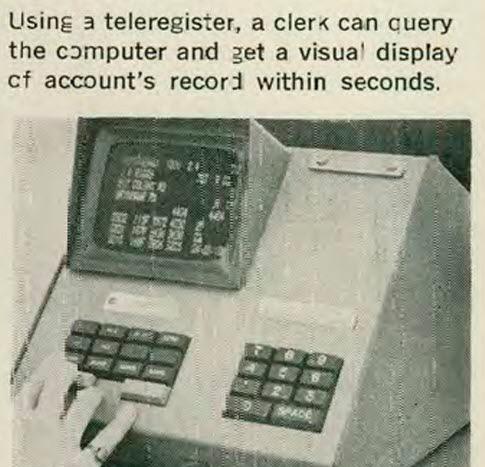
Business Becomes Computerized
BY KEITH REID
Practical, digital computerization dates back to the post-war 1940s with such systems as Britian’s Colossus and ENIAC in the United States. They were initially applied to such tasks as military ballistics calculations and thermonuclear research. Over the next 20 years, this technology matured to where it became increasingly adopted by businesses.
Initially it was used by large corporate entitiets that could devote the millions of dollars, staffing and significant square feet required for the mainframe computer systems of the day. Today, the typical smartphone outpaces the most powerful computers of that era by a significant margin. And yet, even then the ability to digitize and automate certain tasks created revolutionary efficiencies.
The arrival of one such system to the downstream petroleum marketing industry was described in the June 1968 issue of National Petroleum News. The unbylined article, “How to Get Useful Information Out of a Computer in a Flash” described how the oil company Atlantic Richfield (ARCO) figured out how to “pick a computer’s brain for data on a specific account while the account is on the phone, without taking too much time—yours or the account’s.”
Computers of that era typically
operated with a terminal/mainframe model. The mainframe contained the processing system and the storage media—by that point magnetic tape or disc. If you’ve seen a movie from the 1960s featuring “computers” as a backdrop with spinning tape reels on large wardrobe sized cabinets, then you get the gist of what one of these mainframe server rooms looked like. The terminals, manned by office clerks, were typically “dumb” interface devices with a keyboard and basic monitor that were linked to the mainframe either directly through wiring in the same building or over dedicated telephone lines.
The ARCO system was designed to provide basic information on heating oil accounts, where customer service “terminal” clerks handled the product/ customer interactions and could change the delivery status of any account according to the latest wish of the customer (will call or will call automatic). To answer customer inquiries, they could also identify the number, name, address, desired delivery in gallons, whether the tank has full tank signal, “K” factor for winter and summer hot water hookup, record of last delivery showing gallons delivered, degree day of deliveries, next degree day of delivery and the financial side of the last deliveries such as price per gallon, extended
price, truck making the delivery, etc.
Generating a printout for this information was not required as it could be observed on the small terminal monitor.
Credit department clerks could change the credit status of the account in the same way that terminal clerks could switch delivery status, and in all cases receive instant visual feedback that the change has been made.
The benefits to computerization cited then are broadly the same as the benefits cited today. “[The system is not] primarily designed to replace employees,” said Robert Riggs, system and programming division manager. “But it is designed to let the people we do employ handle more business, do it faster, with greater accuracy and lower the unit cost to the company.”
Atlantic Richfield noted the equipment cost used to extract data from the disk file and to make changes (teleregister and teletypewriter) “rents for about $500 per month or about the cost of a good clerk, but it’s capable of doing several times more work.”
That’s not all. The system also helped Atlantic Richfield track its 16,500 employees. In this case, through a printout and not a screen. Stored on three reels of magnetic media were 80 bits of information on each of the company’s employees including birthday, education, job title, work history, benefits record, department and date of employment. “If the company wants to fill a job that requires certain educational background, experience and a certain salary level, it feeds that request into the computer and the search of the tapes is on. Within a short time, a list of candidates meeting the prescribed condition is available.”

For more than 100 years, from its founding in 1909 to when it went out of business in 2013, National Petroleum News (NPN) documented the rise of petroleum marketing and retailing in the United States. NACS, PEI and The Fuels Institute have catalogued the rich history of NPN in its entirety. Each issue of Fuels Market News will look back at the history of our vibrant industry, through the eyes of NPN, to see how it reflect the issues, challenges and opportunities we face today.
Keith Reid is the editor of Fuels Market News.
FuelsMarketNews.com 48 | FMN Magazine SPRING 2024
Conference: October 7-10, 2024
Expo: October 8-10, 2024
Las Vegas Convention Center
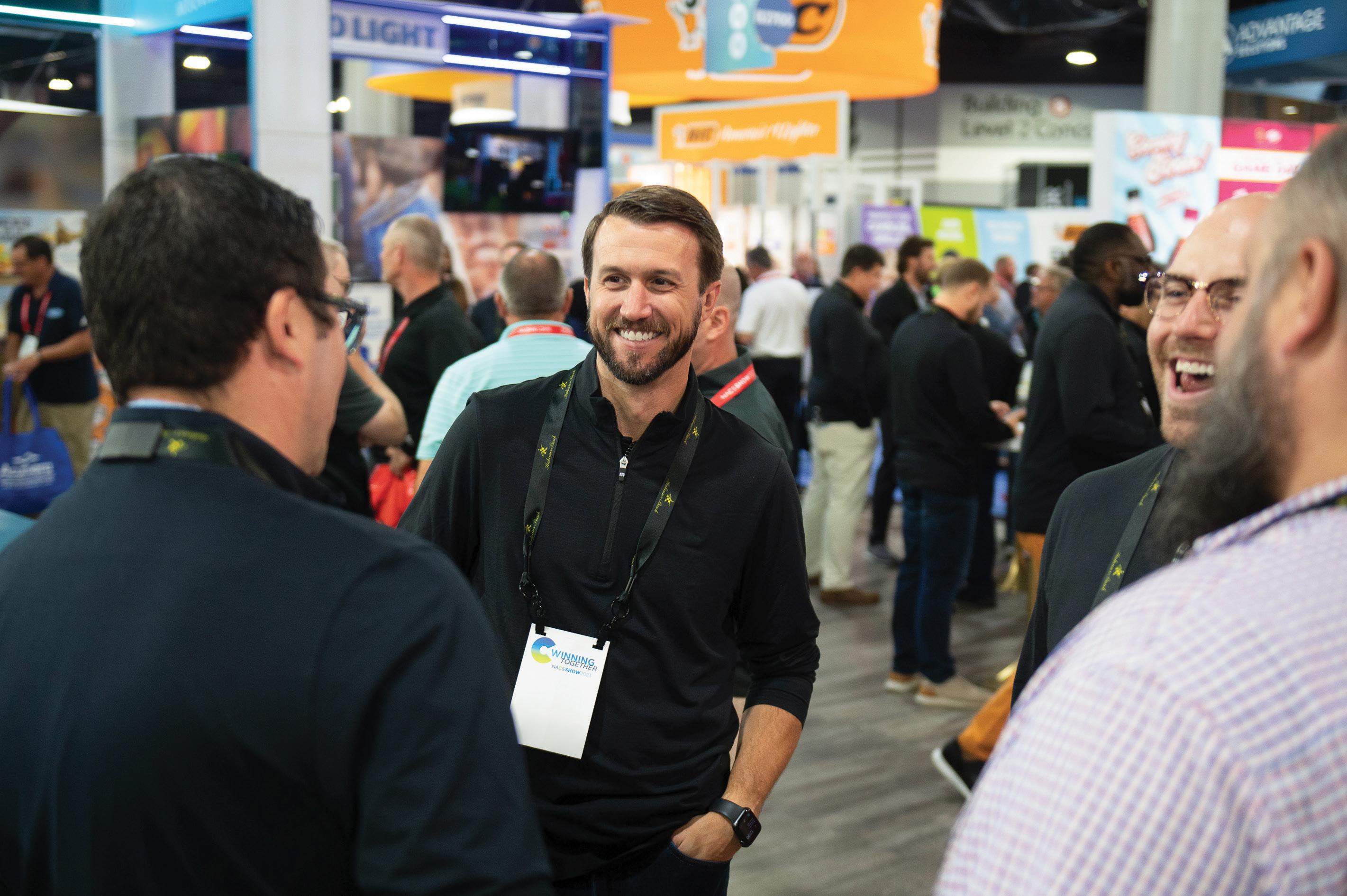

ready to bring it!

The NACS Show gives you four dedicated days with your convenience community to learn from your peers, co-explore the latest products and leave ready to conquer another year of owning convenience!
Be the first to know when Registration Opens Next Month. Add your name to the “notify me” list at nacsshow.com/notify
Scan now to be notified!

We’re back in Vegas!
that fuels the Future
Thank you to our clients for consistently collaborating with us to bring innovative software solutions to the industry.
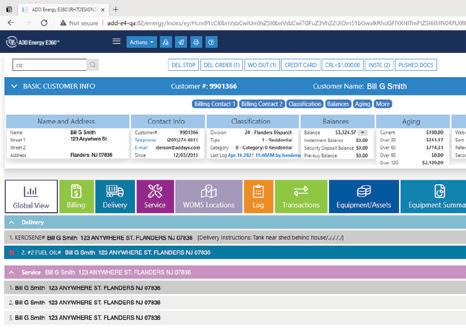



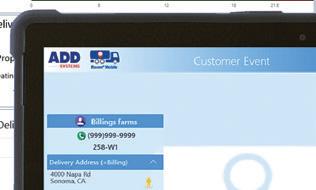
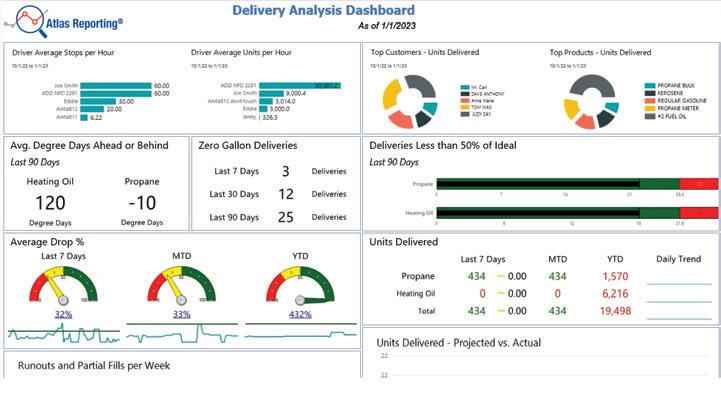









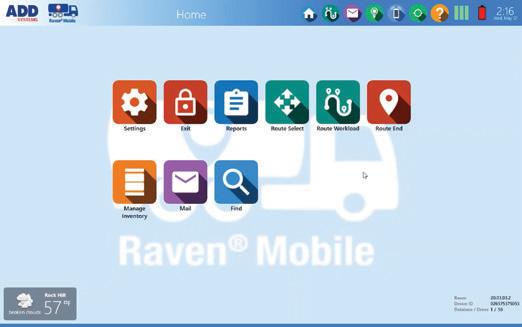







SOFTWARE FOR THE PETROLEUM & CONVENIENCE STORE INDUSTRIES Learn more at addsys.com 800-922-0972
SYSTEMS ALWAYS MOVING FORWARD
Your driver Jim B will be delivering fuel today to 12 East 2nd St. Anywhere, NC ADD ENERGY Co.
Experience


















































 Reggie Roberson CEO, Tank Management Services, Inc. www.TankMgmt.com
Reggie Roberson CEO, Tank Management Services, Inc. www.TankMgmt.com






































 By Keith Reid
By Keith Reid































































































































































































































































































































































 Kaylie Long Scoles Marketing director RDM Industrial Electronics Inc.
Kaylie Long Scoles Marketing director RDM Industrial Electronics Inc.























